Plants
Mt Takao is located at the borderline of warm-temperature zone and cool-temperature zone and various plants from both zones grow. There are a lot of naturally grown plants and their visitors can enjoy seasonal flowers. Over 1,500 kinds of plants are confirmed which is relevant to the number of kinds naturally grow in England. Also, over 60 kinds of plants are first found in Mt. Takao such as Takao Sumire (V. yezoensis f. discolor) and Takao Higodai (Saussurea sinuatoides).
-
Stellaria monosperma Caryophyllaceae
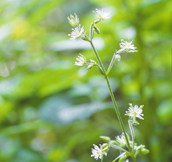
 Stellaria monosperma Caryophyllaceae
Stellaria monosperma Caryophyllaceae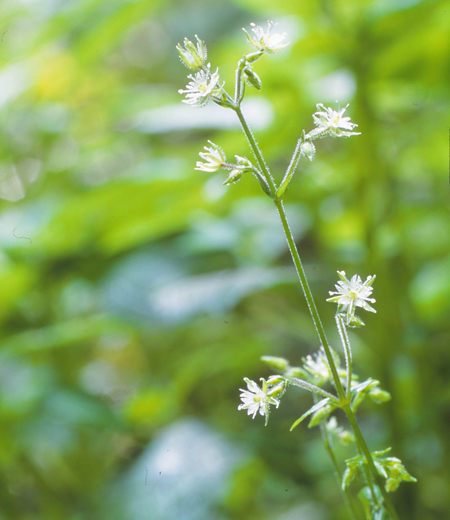 Perennial herbs (grow for several years from their same root system) found in wet forests and at forest edges. Stems grow upright and divided/split into branches at upper part of stem. The Japanese name Ooyama-hakobe literally meaning plants of stellaria family in mountains was named because it s a stellaria family grow in mountains. Flower stems grow from petioles on upper parts of stem and bloom small white flowers. Flowers are 8mm in diameter and have five petals. Petals are lobed deep resembling scissors of crabs. Have five calyx, light green and pointed tip and longer than petals. Bracts and peduncle have tentacles that are hair with nectar-like glue and it is a bit sticky when touched. Leaves are elongated oval shaped, 5 to 10 cm long with pointed tips and wavy edges creating wrinkly looking. After flowering, bear fruits, split and pop seeds when ripen.
Perennial herbs (grow for several years from their same root system) found in wet forests and at forest edges. Stems grow upright and divided/split into branches at upper part of stem. The Japanese name Ooyama-hakobe literally meaning plants of stellaria family in mountains was named because it s a stellaria family grow in mountains. Flower stems grow from petioles on upper parts of stem and bloom small white flowers. Flowers are 8mm in diameter and have five petals. Petals are lobed deep resembling scissors of crabs. Have five calyx, light green and pointed tip and longer than petals. Bracts and peduncle have tentacles that are hair with nectar-like glue and it is a bit sticky when touched. Leaves are elongated oval shaped, 5 to 10 cm long with pointed tips and wavy edges creating wrinkly looking. After flowering, bear fruits, split and pop seeds when ripen.
●Season Mid September to about Late October
●Height about 40 to 80 cm
●Place Trail 1, Trail3 to 4, Trail 6, Ura-Takao -
Dianthus superbus var. longicalycinus Caryophyllaceae
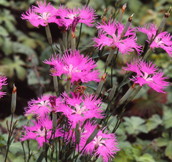
 Dianthus superbus var. longicalycinus Caryophyllaceae
Dianthus superbus var. longicalycinus Caryophyllaceae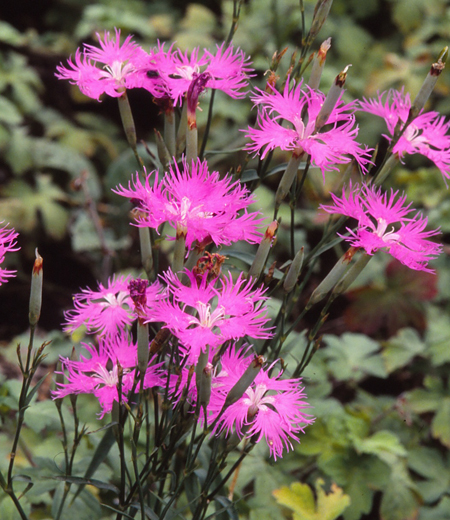 Perennial herbs (grow for several years from their same root system) found in sunny grasslands in mountains. Is one of seven autumn herbs. This plant is simply called dianthus and flowers are very cute that ones want to care for and often found on riverbeds, hence the Japanese name Kawara-nadeshiko endearing flowers on riverbed. Flowers are 4 to 5 cm in diameter, have five petals. Color of flowers is mostly red-purple but varies from deep to light color. Tips of flowers split like threads and have space in between petals and have beards-like hair at the base. Have three to four paired bracts at the base of calyx tube around flowers. Leaves are 3 to 10 cm long, 0.4 to 1 cm width, elongated with pointed tip, powdery white, opposite and cover stems with the lower parts of leaves.
Perennial herbs (grow for several years from their same root system) found in sunny grasslands in mountains. Is one of seven autumn herbs. This plant is simply called dianthus and flowers are very cute that ones want to care for and often found on riverbeds, hence the Japanese name Kawara-nadeshiko endearing flowers on riverbed. Flowers are 4 to 5 cm in diameter, have five petals. Color of flowers is mostly red-purple but varies from deep to light color. Tips of flowers split like threads and have space in between petals and have beards-like hair at the base. Have three to four paired bracts at the base of calyx tube around flowers. Leaves are 3 to 10 cm long, 0.4 to 1 cm width, elongated with pointed tip, powdery white, opposite and cover stems with the lower parts of leaves.
●Season Mid July to about Mid September
●Height about 30 to 80 cm
●Place Oku-Takao -
Stellaria diversiflora Caryophyllaceae
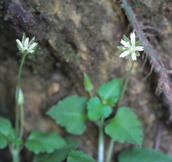
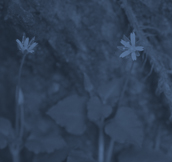 Stellaria diversiflora Caryophyllaceae
Stellaria diversiflora Caryophyllaceae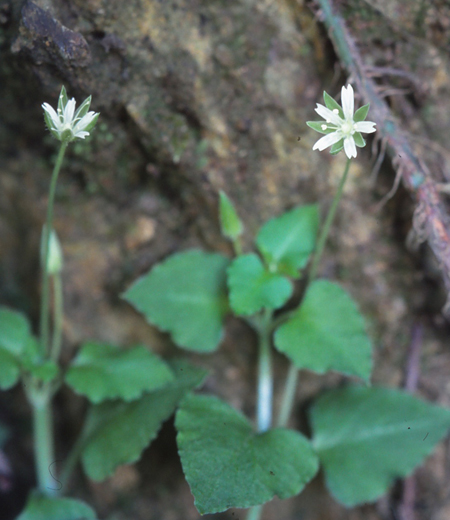 Perennial herbs (grow for several years from their same root system) found in wet areas including forest floors near streams. Stems grow along the ground by rooting from nodes and branches grow upward tilted. Peduncles grow from petioles and bloom one 1 to 1..5 cm long white flower. Have five petals with shallow cuts at tips that resemble thread cutting scissors. Other plants in stellaria family have deeper cuts that are easy to distinguish this plant. Leaves are round-shaped with pointed triangular-like tips and 2 to 4 cm long. Two leaves are opposite, facing each other. Have short hair on the back of leaves. Bear spherical fruits after flowering and pop 2 mm oval-shaped seeds when ripen.
Perennial herbs (grow for several years from their same root system) found in wet areas including forest floors near streams. Stems grow along the ground by rooting from nodes and branches grow upward tilted. Peduncles grow from petioles and bloom one 1 to 1..5 cm long white flower. Have five petals with shallow cuts at tips that resemble thread cutting scissors. Other plants in stellaria family have deeper cuts that are easy to distinguish this plant. Leaves are round-shaped with pointed triangular-like tips and 2 to 4 cm long. Two leaves are opposite, facing each other. Have short hair on the back of leaves. Bear spherical fruits after flowering and pop 2 mm oval-shaped seeds when ripen.
●Season Late May to about Early July
●Height about 10 to 30 cm
●Place Trail 6 -
Persicaria thunbergii Polygonaceae
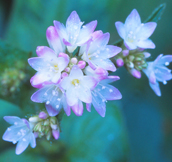
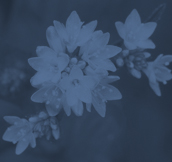 Persicaria thunbergii Polygonaceae
Persicaria thunbergii Polygonaceae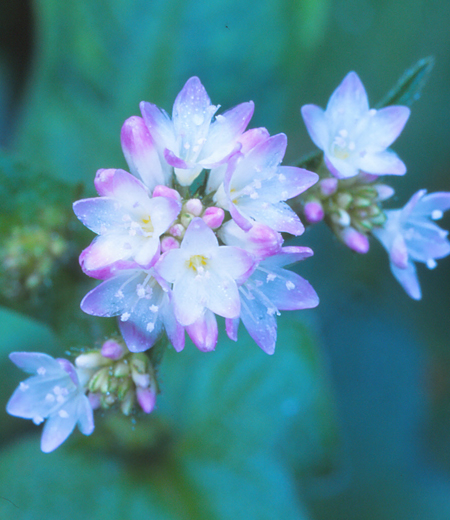 Annual herb found in wet waterside and paths between paddy fields in mountains. Stems grow along the ground and only upper part of plant grows upright. Stems and leaves have prickles facing downward. Flowers are 6 to 8 mm in diameter and about 10 of them bloom at the tips of stems and lobed in five. Color of flowers is light pinkish white and some are red. Leaves are 4 to 10 cm long and alternate. The shape of leaves is called hastate, shaped like a spearhead with pointed tip, narrow in the middle and flaring pointed lobes at the base. The Japanese name Mizo-soba literally meaning ditch buckwheat because the leaves grow on ditches and its shape resemble the leaves of buckwheat. This is also called as Ushino-hitai literally meaning forehead of cows because the leaves also resemble face of cows. After flowering, bear egg-shaped seeds.
Annual herb found in wet waterside and paths between paddy fields in mountains. Stems grow along the ground and only upper part of plant grows upright. Stems and leaves have prickles facing downward. Flowers are 6 to 8 mm in diameter and about 10 of them bloom at the tips of stems and lobed in five. Color of flowers is light pinkish white and some are red. Leaves are 4 to 10 cm long and alternate. The shape of leaves is called hastate, shaped like a spearhead with pointed tip, narrow in the middle and flaring pointed lobes at the base. The Japanese name Mizo-soba literally meaning ditch buckwheat because the leaves grow on ditches and its shape resemble the leaves of buckwheat. This is also called as Ushino-hitai literally meaning forehead of cows because the leaves also resemble face of cows. After flowering, bear egg-shaped seeds.
●Season Mid August to about Late October
●Height about 30 to 90 cm
●Place Trail 1, Trail 6, Ura-Takao -
Yoania amagiensis Orchidaceae
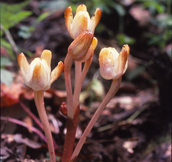
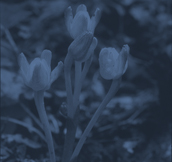 Yoania amagiensis Orchidaceae
Yoania amagiensis Orchidaceae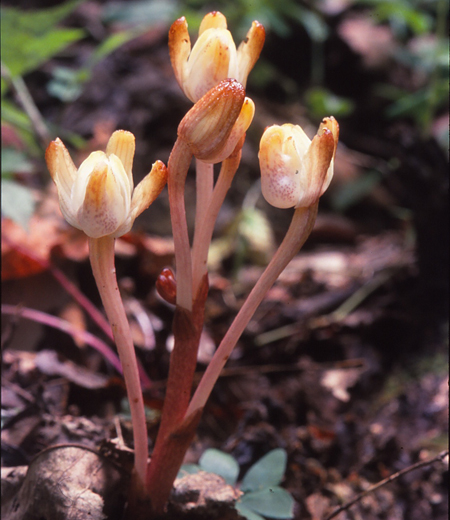 Saprophytic plant (grow on leaf soils and grow with fungi to break down its nutrients) found in wet areas including streamside in mountains. Does not have chlorophyll and cannot produce nutrients and grow by fungi around roots. Underground stems are divided into many branches in clumps and thick flower stem grow upright on ground. Bloom ten light yellow-brown fleshy flowers facing upward. Scale leaves (leaves transformed into small scale-like shape) are at the base of peduncles but it is not distinct. Yellow flowers resemble shoki the god of charm against devils in China and also used in boy’s festivals in May in Japan, hence the Japanese name Kibanano-shoki-ran literally meaning yellow flowers shoki orchid. Flowers are 2 cm in diameter with long peduncles but petals does not open widely compare to yoania japonica in same family. Have yellow hair at tips of petals and have purple spots insides.
Saprophytic plant (grow on leaf soils and grow with fungi to break down its nutrients) found in wet areas including streamside in mountains. Does not have chlorophyll and cannot produce nutrients and grow by fungi around roots. Underground stems are divided into many branches in clumps and thick flower stem grow upright on ground. Bloom ten light yellow-brown fleshy flowers facing upward. Scale leaves (leaves transformed into small scale-like shape) are at the base of peduncles but it is not distinct. Yellow flowers resemble shoki the god of charm against devils in China and also used in boy’s festivals in May in Japan, hence the Japanese name Kibanano-shoki-ran literally meaning yellow flowers shoki orchid. Flowers are 2 cm in diameter with long peduncles but petals does not open widely compare to yoania japonica in same family. Have yellow hair at tips of petals and have purple spots insides.
●Season Mid June to about Mid July
●Height about 20 to 50 cm
●Place Trail 3 -
Liparis kumokiri Orchidaceae
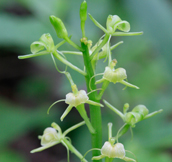
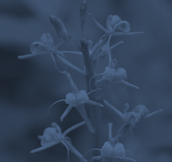 Liparis kumokiri Orchidaceae
Liparis kumokiri Orchidaceae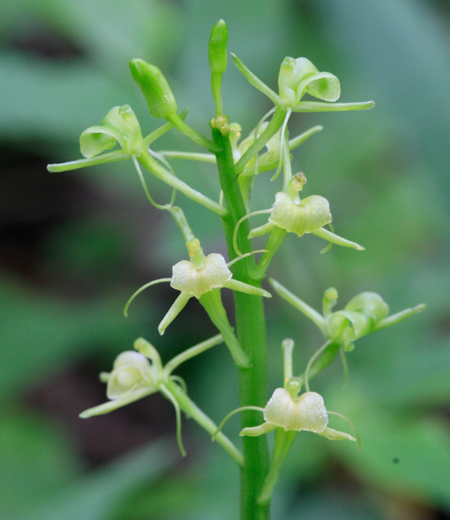 Perennial herbs (grow for several years from their same root system) found at forest edges and in forests in mountains. Two leaves are alternate and flower stems (without leaves) grow and bloom five to fifteen flowers. Petals and bracts are skinny tube-like shaped like legs of insects. Flowers are light green or black-brown. Petals are curled downward at tops and gynostemium (the united stamen and pistil) have lumps of yellow pollens. Leaves are 5 to 12 cm oval-shaped with wavy edges and curl stems at the base. The Japanese name Kumo-kiri-so literally meaning spiders fog plants was named but have no definite theory but one of them is because flowers resembles baby spiders and grow on foggy areas.
Perennial herbs (grow for several years from their same root system) found at forest edges and in forests in mountains. Two leaves are alternate and flower stems (without leaves) grow and bloom five to fifteen flowers. Petals and bracts are skinny tube-like shaped like legs of insects. Flowers are light green or black-brown. Petals are curled downward at tops and gynostemium (the united stamen and pistil) have lumps of yellow pollens. Leaves are 5 to 12 cm oval-shaped with wavy edges and curl stems at the base. The Japanese name Kumo-kiri-so literally meaning spiders fog plants was named but have no definite theory but one of them is because flowers resembles baby spiders and grow on foggy areas.
●Season Early June to about Mid July
●Height about 10 to 20 cm
●Place Trail 5, Ura-Takao -
Galeola septentrionalis Orchidaceae
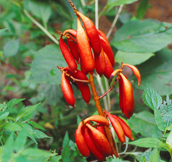
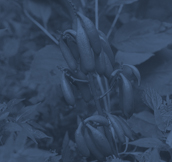 Galeola septentrionalis Orchidaceae
Galeola septentrionalis Orchidaceae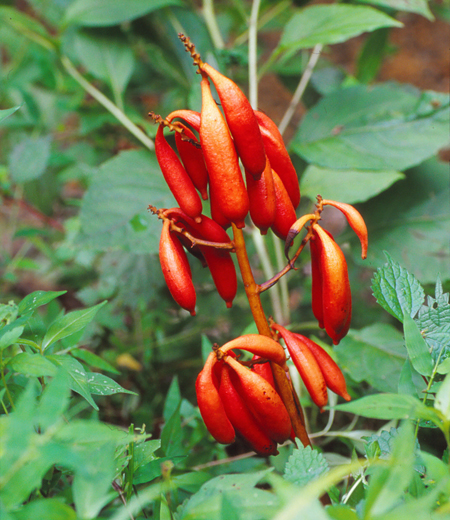 Saprophytic plant (grow on leaf soils and grow with fungi to break down its nutrients) found in forests and shrubs. Does not have chlorophyll and intake fungus of honey mushrooms in roots. Leaves are deteriorated and transformed small scale-like shaped ones grow on thick root stems. Stems are thick with brown hair and have many branches at tips and bloom many flowers. Flowers are 3 cm and yellow-brown. Petals and bracts are about the same size and open to sides and have fine hairs at the outer part of bracts. Petals are thick, fleshy and short with yellow hair-like protrusions. After flowering, bear 6 to 10 cm long sausage-like fleshy red fruits. The Japanese name Tsuchi-akebi was named because the fruits resemble chocolate vine and grow from the ground. It has long been used as the medical herbs to cure tireness and fatigue.
Saprophytic plant (grow on leaf soils and grow with fungi to break down its nutrients) found in forests and shrubs. Does not have chlorophyll and intake fungus of honey mushrooms in roots. Leaves are deteriorated and transformed small scale-like shaped ones grow on thick root stems. Stems are thick with brown hair and have many branches at tips and bloom many flowers. Flowers are 3 cm and yellow-brown. Petals and bracts are about the same size and open to sides and have fine hairs at the outer part of bracts. Petals are thick, fleshy and short with yellow hair-like protrusions. After flowering, bear 6 to 10 cm long sausage-like fleshy red fruits. The Japanese name Tsuchi-akebi was named because the fruits resemble chocolate vine and grow from the ground. It has long been used as the medical herbs to cure tireness and fatigue.
●Season Late June to about Late July
●Height about 50 cm to 1 m
●Place Trail 1 -
Spiranthes sinensis var. amoena Orchidaceae
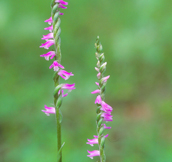
 Spiranthes sinensis var. amoena Orchidaceae
Spiranthes sinensis var. amoena Orchidaceae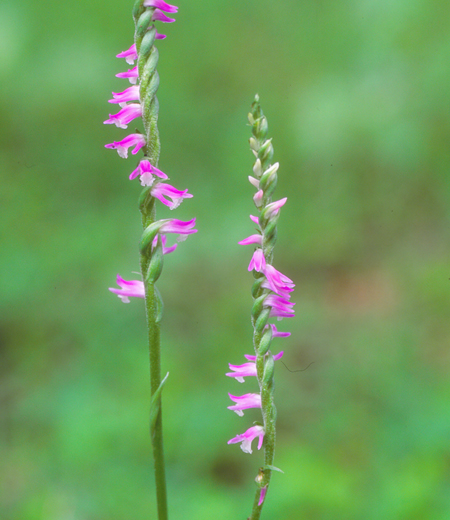 Perennial herbs (grow for several years from their same root system) found in sunny grasslands, on grass areas and narrow paths on paddy fields. Flower stems (without leaves) grow in-between leaves and become spiral at upper parts, hence the Japanese name Neji-bana literally meaning spiral flowers. Both right and left spiral ones but some have them both on one stem. Flowers are 4 to 6 mm and bloom many flowers on 5 to 15 cm long flower spikes. The color is pink but the one on the bottom like a tongue is white with toothed margins and have a shiny protrusion in the center. Have egg-shaped 4 to 8 mm long bracts (transformed parts of leaves at the base of flowers) at the back of petals. Radical leaves (leaves grow from roots) are 5 to 20 cm long and 0.3 to 1 cm width, elongated with pointed tip and wraps stems at the base.
Perennial herbs (grow for several years from their same root system) found in sunny grasslands, on grass areas and narrow paths on paddy fields. Flower stems (without leaves) grow in-between leaves and become spiral at upper parts, hence the Japanese name Neji-bana literally meaning spiral flowers. Both right and left spiral ones but some have them both on one stem. Flowers are 4 to 6 mm and bloom many flowers on 5 to 15 cm long flower spikes. The color is pink but the one on the bottom like a tongue is white with toothed margins and have a shiny protrusion in the center. Have egg-shaped 4 to 8 mm long bracts (transformed parts of leaves at the base of flowers) at the back of petals. Radical leaves (leaves grow from roots) are 5 to 20 cm long and 0.3 to 1 cm width, elongated with pointed tip and wraps stems at the base.
●Season June to about August
●Height about 10 to 30 cm
●Place Trail 1, Trail 5, Ura-Takao, Oku-Takao -
Lecanorchis japonica Orchidaceae
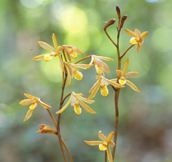
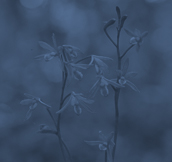 Lecanorchis japonica Orchidaceae
Lecanorchis japonica Orchidaceae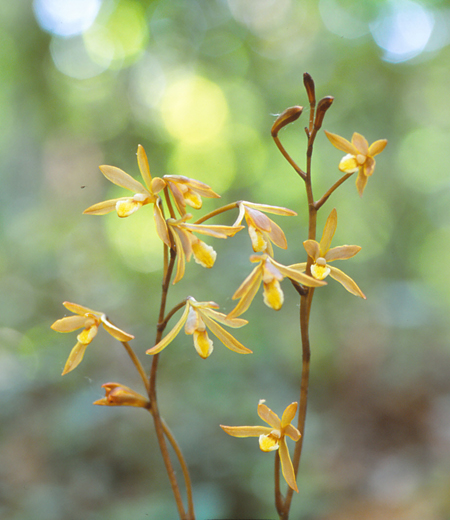 Saprophytic plant (grow on leaf soils and grow with fungi to break down its nutrients) found under evergreen trees in warm climate areas. Grow with nutrients from fungus. Does not have chlorophyll and the entire plant is yellow-brown and looks like died flowers and are not appealing. In Mt Takao, found in oak tree forests during rainy season. The Japanese name is Mu-you-ran literally meaning no leaf orchid and as the name states, leaves are deteriorated and only have scale leaves (leaves transformed into small scale-shaped). Flowers are 2 to 3 cm in diameter and half-open. The color of flowers is light yellow-white and blooms five to six flowers randomly on flower stems (without leaves). Bracts and petals are almost the same shape and about 1..5 cm long. Have yellow hair protrusions inside of the petal protruded. After flowering, bear thin stick-like black fruits.
Saprophytic plant (grow on leaf soils and grow with fungi to break down its nutrients) found under evergreen trees in warm climate areas. Grow with nutrients from fungus. Does not have chlorophyll and the entire plant is yellow-brown and looks like died flowers and are not appealing. In Mt Takao, found in oak tree forests during rainy season. The Japanese name is Mu-you-ran literally meaning no leaf orchid and as the name states, leaves are deteriorated and only have scale leaves (leaves transformed into small scale-shaped). Flowers are 2 to 3 cm in diameter and half-open. The color of flowers is light yellow-white and blooms five to six flowers randomly on flower stems (without leaves). Bracts and petals are almost the same shape and about 1..5 cm long. Have yellow hair protrusions inside of the petal protruded. After flowering, bear thin stick-like black fruits.
●Season Early June to about Early July
●Height about30 to 40 cm
●Place Trail 3 -
Cremastra appendiculata Orchidaceae
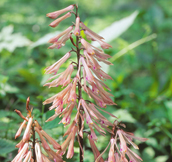
 Cremastra appendiculata Orchidaceae
Cremastra appendiculata Orchidaceae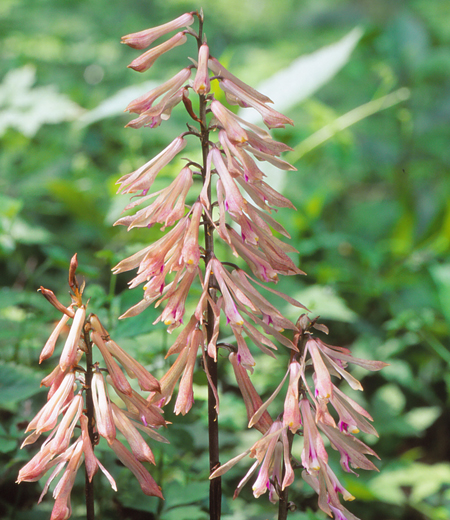 Perennial herbs (grow for several years from their same root system) found in dark areas including forests near streams in mountains. The Japanese name Saihai-ran literally meaning baton orchid because flowers resemble the baton samurai used in Warring States period to give orders to warriors. Flowers are elongated 3 cm long and bloom 10 to 20 flowers facing downward on the upper part of stems. The color of flowers is pinkish brown but some are red. Protruded petal is lobed in three. Gynostemium (the united stamen and pistil) and yellow pollen at its tips are inside of flowers. One oval-shaped 15 to 35 cm long leaf per flower and remain during winter. It is like thin large bamboo leaf and very appealing even during non-blooming seasons.
Perennial herbs (grow for several years from their same root system) found in dark areas including forests near streams in mountains. The Japanese name Saihai-ran literally meaning baton orchid because flowers resemble the baton samurai used in Warring States period to give orders to warriors. Flowers are elongated 3 cm long and bloom 10 to 20 flowers facing downward on the upper part of stems. The color of flowers is pinkish brown but some are red. Protruded petal is lobed in three. Gynostemium (the united stamen and pistil) and yellow pollen at its tips are inside of flowers. One oval-shaped 15 to 35 cm long leaf per flower and remain during winter. It is like thin large bamboo leaf and very appealing even during non-blooming seasons.
●Season Early June to about Early July
●Height about 30 to 50 cm
●Place Trail 1, Trail 3, Trail 6, Ura-Takao, Oku-Takao -
Dioscorea tokoro Dioscoreaceae
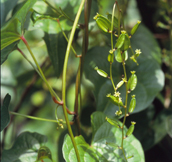
 Dioscorea tokoro Dioscoreaceae
Dioscorea tokoro Dioscoreaceae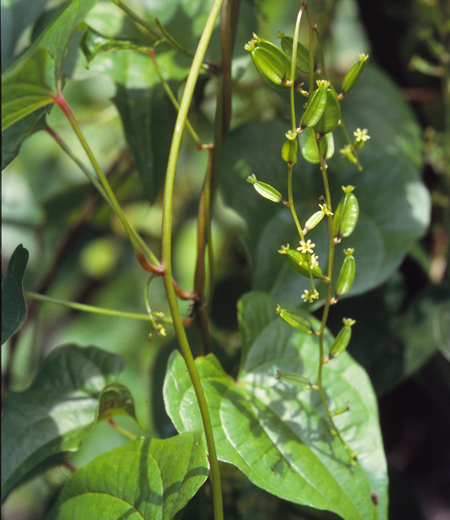 Perennial herbs vines (grow for several years from their same root system) found in mountains. Resembles dioscorea japonica in the same family but leaves of this plants are alternate and does not have bulblets (spherical sprout with nutrients). Underground stems are thick and hard and have many fibers. Often used as a new year ornaments but it is too biter to eat. The Japanese name Oni-doko-ro written as ogre field aged man was named because the fibrous roots resemble aged man on field. Flowers are 5 mm in diameter and light yellow-green. Bloom many flowers on long flower stems (without leaves). Have male and female flowers, male flowers bloom upright from petioles but female flowers bloom dropping. Leaves are 5 to 12 cm round heart-shaped with pointed tip. After flowering, bear fruits with three fins facing upward. Seeds are oval-shaped with wings on one side.
Perennial herbs vines (grow for several years from their same root system) found in mountains. Resembles dioscorea japonica in the same family but leaves of this plants are alternate and does not have bulblets (spherical sprout with nutrients). Underground stems are thick and hard and have many fibers. Often used as a new year ornaments but it is too biter to eat. The Japanese name Oni-doko-ro written as ogre field aged man was named because the fibrous roots resemble aged man on field. Flowers are 5 mm in diameter and light yellow-green. Bloom many flowers on long flower stems (without leaves). Have male and female flowers, male flowers bloom upright from petioles but female flowers bloom dropping. Leaves are 5 to 12 cm round heart-shaped with pointed tip. After flowering, bear fruits with three fins facing upward. Seeds are oval-shaped with wings on one side.
●Season July to about August
●Height Vines
●Place Trail 6, Ura-Takao -
Dioscorea japonica(Japanese Yam) Dioscoreaceae
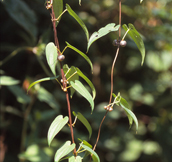
 Dioscorea japonica(Japanese Yam) Dioscoreaceae
Dioscorea japonica(Japanese Yam) Dioscoreaceae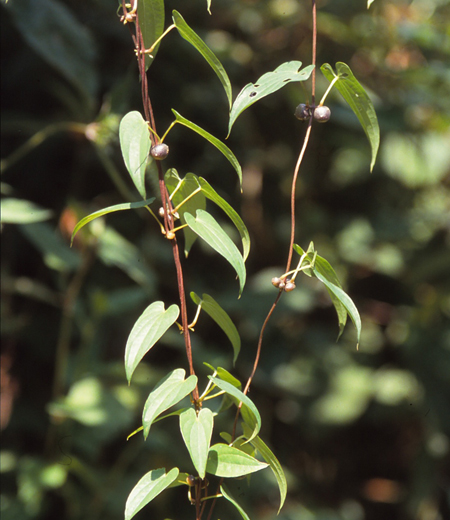 Perennial herbs vines (grow for several years from their same root system) found in forests in mountains. Fleshy and long cylindrical roots grow underground can be eaten as grated yam. The Japanese name Yamano-imo literally meaning potato in mountains was named because it grows in mountains to distinguish sato-imo taro potato grows in rural area. Also called as Jinenjyo, was also named because it also grow in mountains. Leaves are 5 to 10 cm heart-shaped with pointed tip on long petioles, opposite and some have bulblets at the base. Bulblets are 1 cm in diameter spherical shape and can be eaten stir fly or steamed with rice. Have both male and female flowers. Male flowers grow upright from petioles and bloom 3 mm in diameter white flowers. Female flowers are dropping and randomly bloom 3 mm in diameter white flowers. After flowering, bear fruits with three spherical fins.
Perennial herbs vines (grow for several years from their same root system) found in forests in mountains. Fleshy and long cylindrical roots grow underground can be eaten as grated yam. The Japanese name Yamano-imo literally meaning potato in mountains was named because it grows in mountains to distinguish sato-imo taro potato grows in rural area. Also called as Jinenjyo, was also named because it also grow in mountains. Leaves are 5 to 10 cm heart-shaped with pointed tip on long petioles, opposite and some have bulblets at the base. Bulblets are 1 cm in diameter spherical shape and can be eaten stir fly or steamed with rice. Have both male and female flowers. Male flowers grow upright from petioles and bloom 3 mm in diameter white flowers. Female flowers are dropping and randomly bloom 3 mm in diameter white flowers. After flowering, bear fruits with three spherical fins.
●Season Mid August to about Late September
●Height Vines
●Place Trail 1, Trail 4, Trail 6, Ura-Takao, Oku-Takao -
Lycoris sanguinea Amaryllidaceae
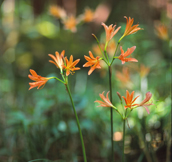
 Lycoris sanguinea Amaryllidaceae
Lycoris sanguinea Amaryllidaceae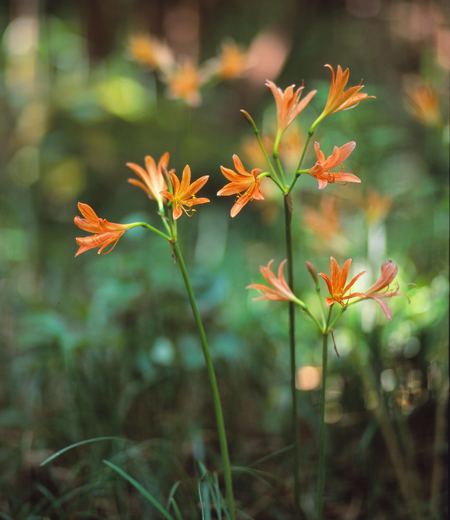 Perennial herbs (grow for several years from their same root system) found at forest edges and grassland near streams in mountains. Grow long leaves in early spring but die in summer and only grow flower stems (flower stems without any leaves) and bloom three to five orange flowers. Leaves are elongated, 30 to 40 cm long. There are several theories the Japanese name Kitsuneno-kamisori literally meaning razor of fox come from, and one of them is that the way this plant looks, flowers bloom without any leaves are quite odd like being witched by a fox and elongated leaves resembling razor. Flowers are 5 to 7 cm in diameter and have six petals and bloom upward tilted. Similar lycoris sanguinea var. kiushiana (Makino) T. koyama have a long stamen protruded but the stamens and petals of this plant are about the same length. Is poisonous and cause vomiting or stomach ache when eaten by mistake.
Perennial herbs (grow for several years from their same root system) found at forest edges and grassland near streams in mountains. Grow long leaves in early spring but die in summer and only grow flower stems (flower stems without any leaves) and bloom three to five orange flowers. Leaves are elongated, 30 to 40 cm long. There are several theories the Japanese name Kitsuneno-kamisori literally meaning razor of fox come from, and one of them is that the way this plant looks, flowers bloom without any leaves are quite odd like being witched by a fox and elongated leaves resembling razor. Flowers are 5 to 7 cm in diameter and have six petals and bloom upward tilted. Similar lycoris sanguinea var. kiushiana (Makino) T. koyama have a long stamen protruded but the stamens and petals of this plant are about the same length. Is poisonous and cause vomiting or stomach ache when eaten by mistake.
●Season Early August to about Early September
●Height about 30 to 50 cm
●Place Ura-Takao -
Hosta montana Liliaceae
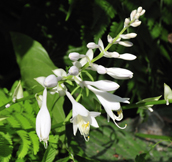
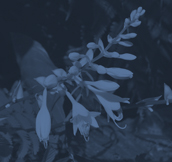 Hosta montana Liliaceae
Hosta montana Liliaceae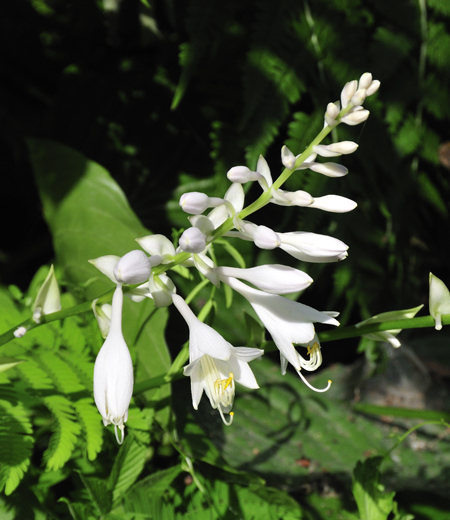 Perennial herbs (grow for several years from their same root system) found in forest edges or web grasslands. Radical leaves are large, 20 to 30 cm long, oval-shaped with pointed tip. On the back of leaves, leaf veins are distinct and there are some small protrusions. Soft young leaves are called Urui and can be eaten as tempura or marinated. Slightly sticky with bitter taste but needs to be careful of selecting as they are often mistaken by a poisonous plant called false helleborine in liliaceae. Flowers are tubular trumpet-like shape and 4 to 5 cm long. Have purple to white flowers on sides of long flower stems and bloom from the bottom ones. Bracts at the base of petals are greenish white. Leaves are large and the shape of buds is like an ornamental cap on a bridge post called giboshi, hence the Japanese name Ooba-gibousi literally meaning large ornamental cap.
Perennial herbs (grow for several years from their same root system) found in forest edges or web grasslands. Radical leaves are large, 20 to 30 cm long, oval-shaped with pointed tip. On the back of leaves, leaf veins are distinct and there are some small protrusions. Soft young leaves are called Urui and can be eaten as tempura or marinated. Slightly sticky with bitter taste but needs to be careful of selecting as they are often mistaken by a poisonous plant called false helleborine in liliaceae. Flowers are tubular trumpet-like shape and 4 to 5 cm long. Have purple to white flowers on sides of long flower stems and bloom from the bottom ones. Bracts at the base of petals are greenish white. Leaves are large and the shape of buds is like an ornamental cap on a bridge post called giboshi, hence the Japanese name Ooba-gibousi literally meaning large ornamental cap.
●Season Mid July to about Late August
●Height about 50 to 90 cm
●Place Oku-Takao -
Ophiopogon planiscapus Liliaceae
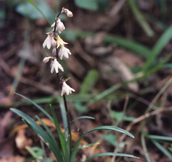
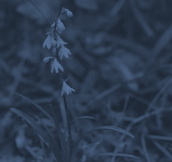 Ophiopogon planiscapus Liliaceae
Ophiopogon planiscapus Liliaceae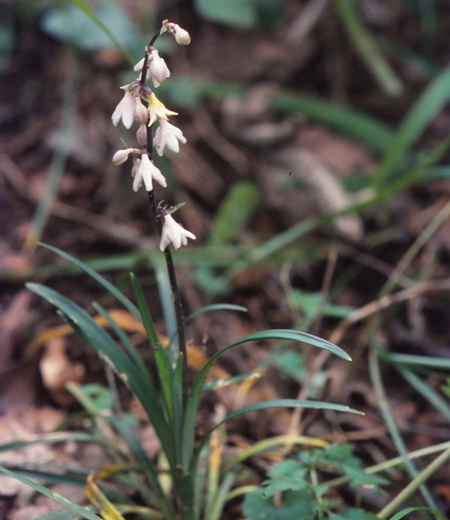 Perennial herbs (grow for several years from their same root system) found under evergreen trees or shady areas in mountains. Long vines grow underground and often found in clusters. The Japanese name Ooba-jyano-hige literally meaning large leaf beards of snakes was named because leaves resemble beards of snakes and this plant has wide and thick leaves compare to other plants in ophiopogon genes. Leaves grow from roots are elongated and 20 to 40 cm long. Have shiny surface but edges are rough. Flowers are 6 to 7 mm long and white or light purple. In Mt. Takao, white ones are more often found. Slightly curved flower stems are facing downward and bloom from the bottom ones. Skin of fruits drop at early stage and seeds are not covered with anything. Become grayish dark green when ripen.
Perennial herbs (grow for several years from their same root system) found under evergreen trees or shady areas in mountains. Long vines grow underground and often found in clusters. The Japanese name Ooba-jyano-hige literally meaning large leaf beards of snakes was named because leaves resemble beards of snakes and this plant has wide and thick leaves compare to other plants in ophiopogon genes. Leaves grow from roots are elongated and 20 to 40 cm long. Have shiny surface but edges are rough. Flowers are 6 to 7 mm long and white or light purple. In Mt. Takao, white ones are more often found. Slightly curved flower stems are facing downward and bloom from the bottom ones. Skin of fruits drop at early stage and seeds are not covered with anything. Become grayish dark green when ripen.
●Season Late June to about Mid July
●Height about 15 to 25 cm
●Place Trail 2 to 3, Trail 5, Kita-Takao -
Hemerocallis fulva var. longituba Liliaceae
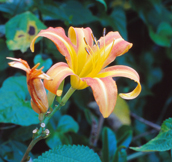
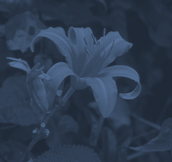 Hemerocallis fulva var. longituba Liliaceae
Hemerocallis fulva var. longituba Liliaceae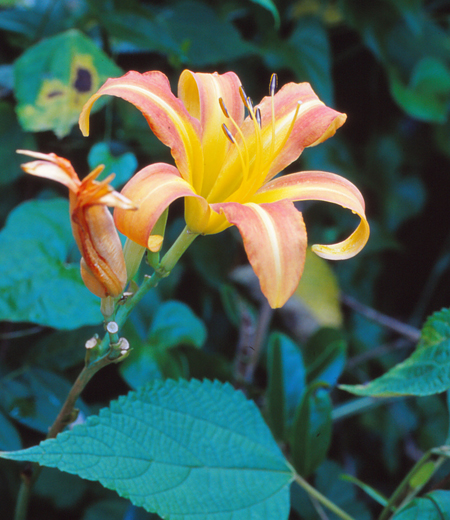 Perennial herbs (grow for several years from their same root system) found in wet areas including roads or ditches in paddy fields. Grow thick flower stems (without any leaves) and bloom some reddish orange flowers. The color varies from deep to light. The ones with strong red are called Beni-kanzo red plants in glycyrrhiza genes. Flowers are 6 petals open like trumpet single flowers and ephemeral flowers which bloom in the morning and wither in the late afternoon. Flowers are 5 to 7 cm long with 6 stamens protrudes from the center. Leaves are elongated, 30 to 60 cm long, 1 to 1..5 cm width and grow from roots and bent like an arrow. Does not bear fruits and grow by extending stems along the ground. Young leaves or bus are sweet and sticky and can be eaten as boiled or tempura.
Perennial herbs (grow for several years from their same root system) found in wet areas including roads or ditches in paddy fields. Grow thick flower stems (without any leaves) and bloom some reddish orange flowers. The color varies from deep to light. The ones with strong red are called Beni-kanzo red plants in glycyrrhiza genes. Flowers are 6 petals open like trumpet single flowers and ephemeral flowers which bloom in the morning and wither in the late afternoon. Flowers are 5 to 7 cm long with 6 stamens protrudes from the center. Leaves are elongated, 30 to 60 cm long, 1 to 1..5 cm width and grow from roots and bent like an arrow. Does not bear fruits and grow by extending stems along the ground. Young leaves or bus are sweet and sticky and can be eaten as boiled or tempura.
●Season July to about August
●Height about 50 to 70 cm
●Place Ura-Takao, Minami-Takao -
Liriope minor Liliaceae
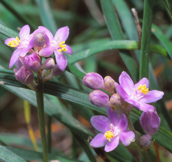
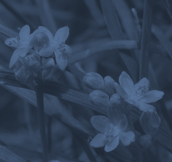 Liriope minor Liliaceae
Liriope minor Liliaceae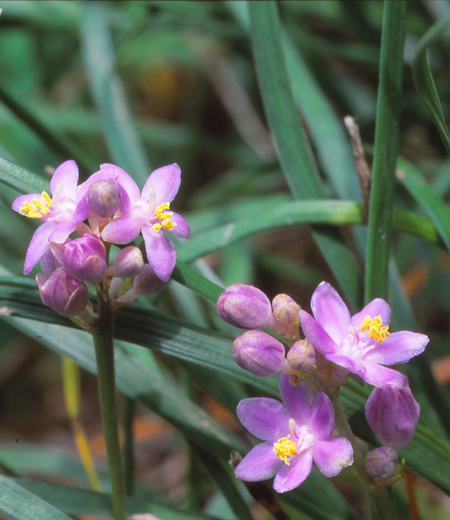 Perennial herbs (grow for several years from their same root system) found in sunny grasslands in mountains. Grow runners by rooting at nodes and often found in clusters. Radical leaves (leaves grow from roots) grow randomly and grow upright 10 to 15 cm long flower stems (without any leaves). At the tip of flower stems, bloom several light purple flowers facing upward but some are white. Flowers are 1 cm in diameter with six oval-shaped flowers open flat. Leaves are elongated, 10 to 20 cm long, 2 to 3 mm width. Liriope muscari in the same family also have skinny leaves but the way flowers grow is different. After flowering, bear seeds like shiny fruits. Seeds are 4 to 6 mm in diameter spherical-shaped which is green at first and turns to black-purple when ripen.
Perennial herbs (grow for several years from their same root system) found in sunny grasslands in mountains. Grow runners by rooting at nodes and often found in clusters. Radical leaves (leaves grow from roots) grow randomly and grow upright 10 to 15 cm long flower stems (without any leaves). At the tip of flower stems, bloom several light purple flowers facing upward but some are white. Flowers are 1 cm in diameter with six oval-shaped flowers open flat. Leaves are elongated, 10 to 20 cm long, 2 to 3 mm width. Liriope muscari in the same family also have skinny leaves but the way flowers grow is different. After flowering, bear seeds like shiny fruits. Seeds are 4 to 6 mm in diameter spherical-shaped which is green at first and turns to black-purple when ripen.
●Season Early July to about Early September
●Height about 5 to 15 cm
●Place Trail 5, Mt. Inari, Oku-Takao -
Hemerocallis fulva var. kwanso Liliaceae
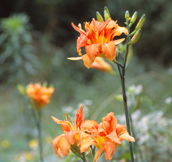
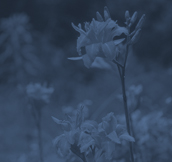 Hemerocallis fulva var. kwanso Liliaceae
Hemerocallis fulva var. kwanso Liliaceae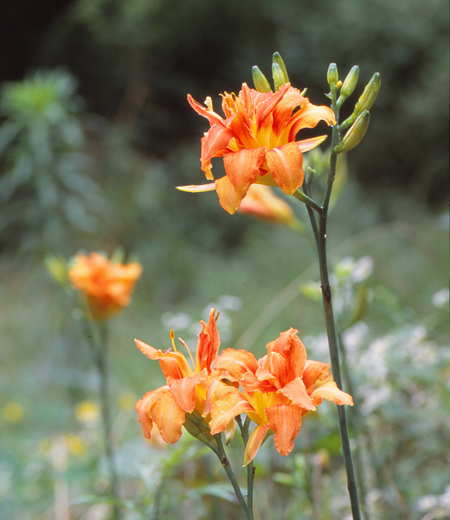 Perennial herbs (grow for several years from their same root system) found at forest edges, roadside and riverbank in mountains. It was originally from China in ancient time. Long stem grow between leaves and bloom some orange flowers at the tip. Flowers are 8 cm in diameter and ephemeral flowers whither in a day. Stamens and pistils transformed into petals creating double flowers that are unique to this plant. Similar hemerocallis fulva var. longituba is single flowers. This is easy to identify this plant. Leaves grow from roots are elongated, 40 to 60 cm long, 2..5 to 4 cm width. Does not bear seeds and grow by bulbs (enlarged leaves with nutrients grow on short stems). Sprout in spring can be eaten marinated or tempura after boiled with salt water and immersed in water.
Perennial herbs (grow for several years from their same root system) found at forest edges, roadside and riverbank in mountains. It was originally from China in ancient time. Long stem grow between leaves and bloom some orange flowers at the tip. Flowers are 8 cm in diameter and ephemeral flowers whither in a day. Stamens and pistils transformed into petals creating double flowers that are unique to this plant. Similar hemerocallis fulva var. longituba is single flowers. This is easy to identify this plant. Leaves grow from roots are elongated, 40 to 60 cm long, 2..5 to 4 cm width. Does not bear seeds and grow by bulbs (enlarged leaves with nutrients grow on short stems). Sprout in spring can be eaten marinated or tempura after boiled with salt water and immersed in water.
●Season Early July to about Mid August
●Height about 80 cm to 1 m
●Place Trail 6, Ura-Takao, Oku-Takao -
Liriope platyphylla Liliaceae
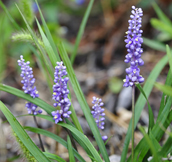
 Liriope platyphylla Liliaceae
Liriope platyphylla Liliaceae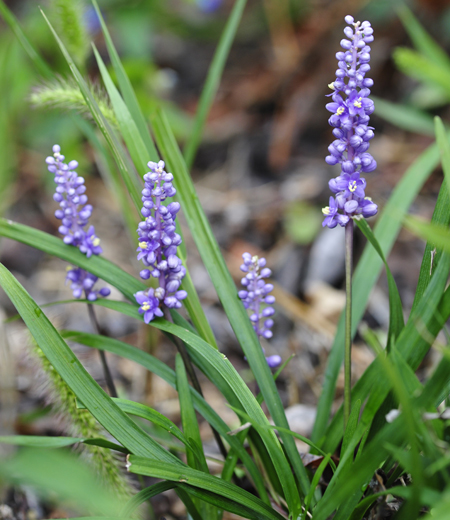 Perennial evergreen herbs (grow for several years from their same root system) found at forest edges and tree shades in forests in mountains and also used as ground cover at parks and gardens. Have many radical leaves (leaves grow from roots) and become a large rootstock and grow 8 to 12 cm long flower stems and bloom 8 mm in diameter small flowers in clusters. The color is light purple with six petals and six yellow stamens. Leaves are skinny 30 to 50 cm long, 0..8 to 1..2 cm width and deep green and shiny surface. Grow in shrubs and leaves resembles orchid, hence the Japanese name Yabu-ran literally meaning shrub orchid. After flowering, bear seeds looks like shiny fruits. Seeds are 6 to 7 mm in diameter spherical shaped and the color is green at first and turns to black-purple when ripen in autumn.
Perennial evergreen herbs (grow for several years from their same root system) found at forest edges and tree shades in forests in mountains and also used as ground cover at parks and gardens. Have many radical leaves (leaves grow from roots) and become a large rootstock and grow 8 to 12 cm long flower stems and bloom 8 mm in diameter small flowers in clusters. The color is light purple with six petals and six yellow stamens. Leaves are skinny 30 to 50 cm long, 0..8 to 1..2 cm width and deep green and shiny surface. Grow in shrubs and leaves resembles orchid, hence the Japanese name Yabu-ran literally meaning shrub orchid. After flowering, bear seeds looks like shiny fruits. Seeds are 6 to 7 mm in diameter spherical shaped and the color is green at first and turns to black-purple when ripen in autumn.
●Season Mid August to about Early October
●Height about 30 to 50 cm
●Place Trail 2, Trail 5, Ura-Takao -
Tricyrtis macropoda Liliaceae
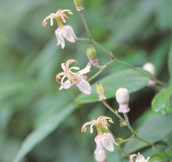
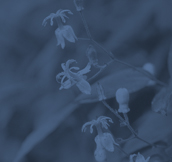 Tricyrtis macropoda Liliaceae
Tricyrtis macropoda Liliaceae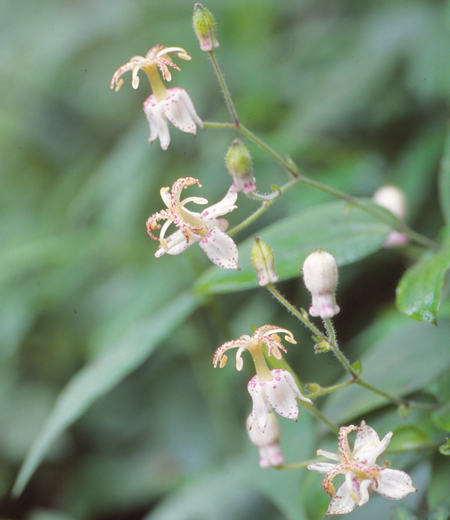 Perennial herbs (grow for several years from their same root system) found at forest edges and in forests in mountains. Flower stems (only bloom flowers without any leaves) grow at the tips of stems or from petioles and bloom some flowers facing upward. Flowers are 3 cm in diameter and have purple spots on white petals. This spots resemble the pattern of the chest of lesser cuckoo, hence the Japanese name Yama-hototogisu literally meaning lesser cuckoo in mountains. Six petals curled downward and stamens and pistils protrude like fountains. Leaves are 8 to 13 cm oval-shaped with pointed tip but curl stems at the base. Stems have hair facing downward but amount of hair vary to each plant. After flowering, bear 3 cm long fruits. Split from the upper side and pop small oval-shaped seeds when ripen.
Perennial herbs (grow for several years from their same root system) found at forest edges and in forests in mountains. Flower stems (only bloom flowers without any leaves) grow at the tips of stems or from petioles and bloom some flowers facing upward. Flowers are 3 cm in diameter and have purple spots on white petals. This spots resemble the pattern of the chest of lesser cuckoo, hence the Japanese name Yama-hototogisu literally meaning lesser cuckoo in mountains. Six petals curled downward and stamens and pistils protrude like fountains. Leaves are 8 to 13 cm oval-shaped with pointed tip but curl stems at the base. Stems have hair facing downward but amount of hair vary to each plant. After flowering, bear 3 cm long fruits. Split from the upper side and pop small oval-shaped seeds when ripen.
●Season Mid August to about Early October
●Height about 40 to 70 cm
●Place Trail 2, Trail 4, Trail 6, Ura-Takao -
Lilium auratum Liliaceae
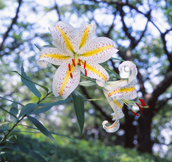
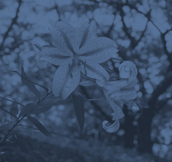 Lilium auratum Liliaceae
Lilium auratum Liliaceae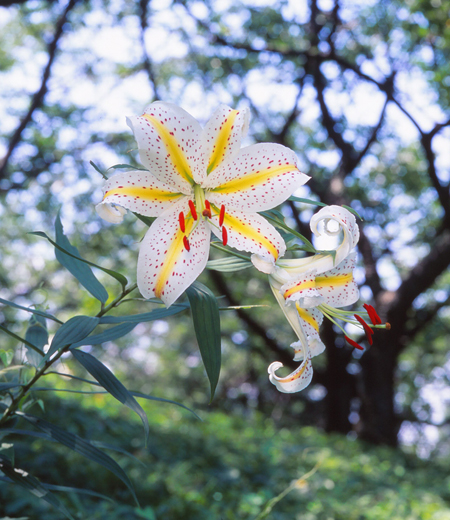 Perennial herbs (grow for several years from their same root system) found at forest edges and grasslands in mountains. Stems grow upright and large ones bloom more than 10 flowers. Flowers are 22 to 24 cm in diameter and recognize its strong scent even from the distance. Six petals are curled outward with yellow line in center with red spots. Red-brown pollens are difficult to come of when touched clothes. It is often found in mountain areas, hence the Japanese name Yamayuri literally meaning lily in mountains. Lily in Japanese is called yuri and was named because it swings by winds. Swing is yureru in Japanese and then started to call the flowers as yuri. Leaves are 10 to 15 m long with short petioles. Bulbs (enlarged leaves with nutrients grow on short stems) are large and edible. After flowering, bear 5 cm long cylindrical fruits facing upward.
Perennial herbs (grow for several years from their same root system) found at forest edges and grasslands in mountains. Stems grow upright and large ones bloom more than 10 flowers. Flowers are 22 to 24 cm in diameter and recognize its strong scent even from the distance. Six petals are curled outward with yellow line in center with red spots. Red-brown pollens are difficult to come of when touched clothes. It is often found in mountain areas, hence the Japanese name Yamayuri literally meaning lily in mountains. Lily in Japanese is called yuri and was named because it swings by winds. Swing is yureru in Japanese and then started to call the flowers as yuri. Leaves are 10 to 15 m long with short petioles. Bulbs (enlarged leaves with nutrients grow on short stems) are large and edible. After flowering, bear 5 cm long cylindrical fruits facing upward.
●Season Mid July to about Early August
●Height 1 to 1.5 m
●Place Trail 1, Mt. Inari, Ura-Takao, Oku-Takao, Minami-Takao -
Commelina communis(Dayflower) Commelinaceae
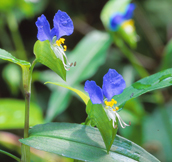
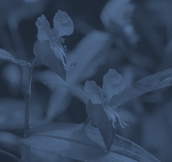 Commelina communis(Dayflower) Commelinaceae
Commelina communis(Dayflower) Commelinaceae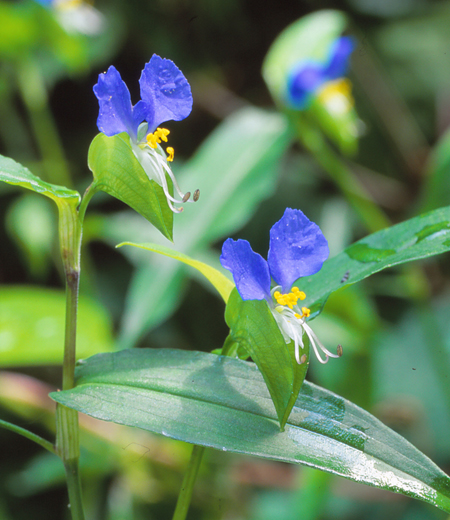 Annual herbs found in grasslands and at roadside. The lower parts of stems grow along the ground by rooting at nodes. Flowers are ephemeral flowers which only bloom one day, bloom in the morning and close around noon. The Japanese name Tsuyukusa literally meaning coloring plants because this flower was used to dye cloth. Flowers are 1..5 cm in diameter and color is bright blue. Have three petals, two on upper parts is large and lower one is white. Six yellow stamens protrude from the center of flowers but four of them are fake with no pollen. Self-pollinate when closing flowers but pollination is also by insects. Leaves are thin and elongated like bamboo leaf, 5 to 6 cm long, alternate and bottom of leaves wrap stem.
Annual herbs found in grasslands and at roadside. The lower parts of stems grow along the ground by rooting at nodes. Flowers are ephemeral flowers which only bloom one day, bloom in the morning and close around noon. The Japanese name Tsuyukusa literally meaning coloring plants because this flower was used to dye cloth. Flowers are 1..5 cm in diameter and color is bright blue. Have three petals, two on upper parts is large and lower one is white. Six yellow stamens protrude from the center of flowers but four of them are fake with no pollen. Self-pollinate when closing flowers but pollination is also by insects. Leaves are thin and elongated like bamboo leaf, 5 to 6 cm long, alternate and bottom of leaves wrap stem.
●Season Mid July to about Mid September
●Height about 20 to 40 cm
●Place Trail 1, Trail 3 to 4, Trail 6, Mt. Inari, Jyataki, Ura-Takao, Oku-Takao, Kita-Takao -
Pollia japonica Commelinaceae
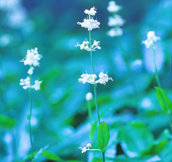
 Pollia japonica Commelinaceae
Pollia japonica Commelinaceae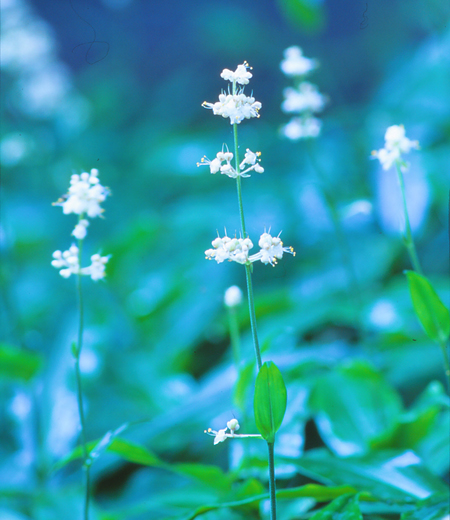 Perennial herbs (grow for several years from their same root system) found at forest edges near streams and in wet forests. Grow long upright stem and bloom many white small flowers. Stems are hairy and rough texture. White underground stems grow horizontally on top of ground. Flowers are 6 to 8 cm in diameter and five to six in tiers creating clusters. Flowers are ephemeral flowers that bloom only one day. Male flower and bisexual flower are mixed. Leaves are elongated oval-shaped, 15 to 30 cm and open in the middle of stem in whorls of six or seven leaves. The Japanese name Yabu-myoga literally meaning shrubs myoga because leaves of this plant resemble those of myoga and grow in shrubs. After flowering, bear spherical fruits, about 5 mm in diameter with full of moisture. Fruits are white at first and become indigo blue in autumn.
Perennial herbs (grow for several years from their same root system) found at forest edges near streams and in wet forests. Grow long upright stem and bloom many white small flowers. Stems are hairy and rough texture. White underground stems grow horizontally on top of ground. Flowers are 6 to 8 cm in diameter and five to six in tiers creating clusters. Flowers are ephemeral flowers that bloom only one day. Male flower and bisexual flower are mixed. Leaves are elongated oval-shaped, 15 to 30 cm and open in the middle of stem in whorls of six or seven leaves. The Japanese name Yabu-myoga literally meaning shrubs myoga because leaves of this plant resemble those of myoga and grow in shrubs. After flowering, bear spherical fruits, about 5 mm in diameter with full of moisture. Fruits are white at first and become indigo blue in autumn.
●Season Mid August to about Mid September
●Height about 50 cm to 1 m
●Place Trail 1 to 2, Trail 4 to 6, Mt. Inari, Jyataki, Ura-Takao -
Cirsium microspicatum Compositae
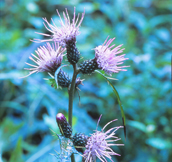
 Cirsium microspicatum Compositae
Cirsium microspicatum Compositae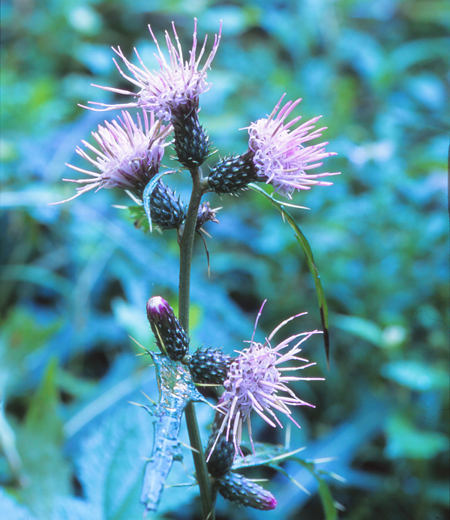 They are a perennial plant that grows in the pool of the forests and in the forests, and along the mountain streams in a mountain district (Perennial plant takes several years to grow). While Cirsium spicatum (Yama-azami) inhabit in Kyushu and Shikoku regions, they grow much in Kanto (ancient name is Azua) region. This is why they are named. The flower consists of lots of dense small flowers in cluster, which is capitulum (Touka: a flower consisting of small dense tubular flowers), and 1 to 3 of them bloom downward at the top of the stalk. The flowers are tinged with red-purple with a cylindrical involucre (Soho: a portion like a bud to cover). The cylindrical involucre is about 1.5 cm long with dense trichome and sticky a little. The leaves grown from the stalk are thin and long about 20 cm long, split pinnately (Ujo: leaves like bird’s wings, a pinnately compound leaf) with the sharp top and the prickled edges. The radical leaf (KON-SEI-YO: leaf spring up from the place about stalk root) bears white-tinged patterns on it, and withers during the blossom season. When the blossom season is over, they produce the seed with white cottony trichome around it. In the winter, we can see ‘Shimobashira’ (ice column). This is caused by the liquid inside the withered stems get frozen to be swollen. Consequently, ice columns are like an ice bloom.
They are a perennial plant that grows in the pool of the forests and in the forests, and along the mountain streams in a mountain district (Perennial plant takes several years to grow). While Cirsium spicatum (Yama-azami) inhabit in Kyushu and Shikoku regions, they grow much in Kanto (ancient name is Azua) region. This is why they are named. The flower consists of lots of dense small flowers in cluster, which is capitulum (Touka: a flower consisting of small dense tubular flowers), and 1 to 3 of them bloom downward at the top of the stalk. The flowers are tinged with red-purple with a cylindrical involucre (Soho: a portion like a bud to cover). The cylindrical involucre is about 1.5 cm long with dense trichome and sticky a little. The leaves grown from the stalk are thin and long about 20 cm long, split pinnately (Ujo: leaves like bird’s wings, a pinnately compound leaf) with the sharp top and the prickled edges. The radical leaf (KON-SEI-YO: leaf spring up from the place about stalk root) bears white-tinged patterns on it, and withers during the blossom season. When the blossom season is over, they produce the seed with white cottony trichome around it. In the winter, we can see ‘Shimobashira’ (ice column). This is caused by the liquid inside the withered stems get frozen to be swollen. Consequently, ice columns are like an ice bloom.
●Season Early September to about Late October
●Height about 1.5 to 2 m
●Place Trail 1 and 2, Ura-Takao, Oku-Takao -
Ainsliaea acerifolia var. subapoda Compositae
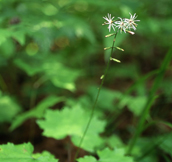
 Ainsliaea acerifolia var. subapoda Compositae
Ainsliaea acerifolia var. subapoda Compositae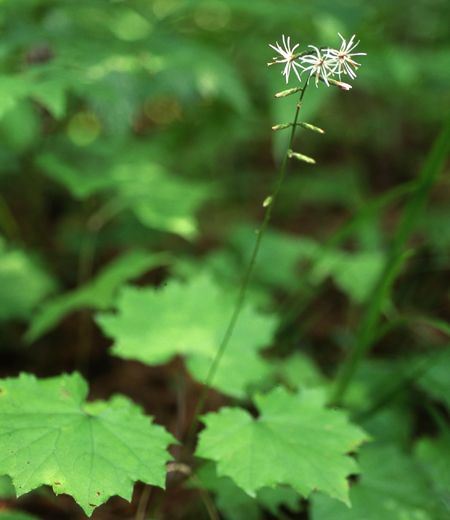 They are a perennial plant that grows at the shady places in the forests at the mountain area (Perennial plant takes several years to grow). The name comes from the facts that they grow at the mountain areas and the shape of the leaf looks like the one of autumn leaves. A part of their name ‘Haguma’ is the pelage (hair) of yak (animal), the appearance of the flower is compared as one of the Buddhist altar articles made of this yak’s hair. The leaf is about 6 to 12 cm long, have a long leafstalk, and 4 to 7 of them whorl at a part around the middle of the stalk (whorl: Rinsei is leaves growing as if they are surrounding the stalk). The leaves are thin feeling to touch and have a palmate leaf (Shoujou) split shallow the same way as autumn leaves. They have a sawtooth (Kyoshi: tooth-like rough part like a saw at the root of a leaf) at the edge, and has pubescence (Nann-mo: soft hair) on both surfaces. From the center among the leaves grown in cluster, does a flower stalk (Kakei: stem of flower bearing only flowers without leaves) sprout with some of the flowers bloom sideways. The flower consists of apitulum (Touka: a flower consisting of small dense tubular flowers) of 3 small flowers, about 1.5 to 1.8 cm. The flower petal is split into 5 with the tip curled, which seems to be a ribbon spread open. When the flowers wither, they bear the seeds with a feathery trichome around them.
They are a perennial plant that grows at the shady places in the forests at the mountain area (Perennial plant takes several years to grow). The name comes from the facts that they grow at the mountain areas and the shape of the leaf looks like the one of autumn leaves. A part of their name ‘Haguma’ is the pelage (hair) of yak (animal), the appearance of the flower is compared as one of the Buddhist altar articles made of this yak’s hair. The leaf is about 6 to 12 cm long, have a long leafstalk, and 4 to 7 of them whorl at a part around the middle of the stalk (whorl: Rinsei is leaves growing as if they are surrounding the stalk). The leaves are thin feeling to touch and have a palmate leaf (Shoujou) split shallow the same way as autumn leaves. They have a sawtooth (Kyoshi: tooth-like rough part like a saw at the root of a leaf) at the edge, and has pubescence (Nann-mo: soft hair) on both surfaces. From the center among the leaves grown in cluster, does a flower stalk (Kakei: stem of flower bearing only flowers without leaves) sprout with some of the flowers bloom sideways. The flower consists of apitulum (Touka: a flower consisting of small dense tubular flowers) of 3 small flowers, about 1.5 to 1.8 cm. The flower petal is split into 5 with the tip curled, which seems to be a ribbon spread open. When the flowers wither, they bear the seeds with a feathery trichome around them.
●Season Mid September to about Mid October
●Height about 40 to 70 cm
●Place Trail 1,Trail 4 and 5, Mt.Inari, Ura-Takao, Oku-Takao -
Atractylodes japonica Compositae
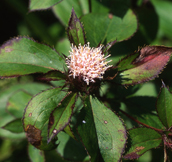
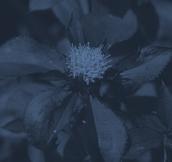 Atractylodes japonica Compositae
Atractylodes japonica Compositae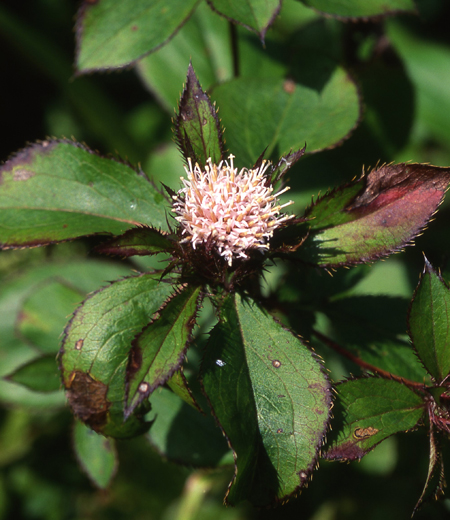 They are a perennial plant that grows at the arid places such as along the ridges and in the grasslands at the mountain area (Perennial plant takes several years to grow). The stem is thin, hard, and has white pubescent at first. It is said that their ancient name is Ukera (Atractylodes japonica Koidz) and has come in Manyosyu (one of the most renowned collection of poems, compiled in the 8th century), and that this ancient name is accented into a current name Okera (Atractylodes lancea DC.). The flower consists of apitulum (Touka: a flower consisting of small dense tubular flowers) of small tubular flowers in cluster, about 2 cm long, tinged with white color, rarely some are pale showy pink. Their characteristic is that involucre (Soho: a portion like a bud to cover) growing below the flower has phyllary (Soho-hen) which seems to be fish bone. The leaf is tubular about 5 to 6 cm long, hard feeling to touch, split into 3 to 5, and with stingy sawtooth at the edge (Kyoshi: tooth-like rough part like a saw at the root of a leaf). When the flowers wither, they bear the seeds with a feathery trichome around them. Young leaves are edible as boiled food after boiled or fried into Tempura. The root has been utilized for gastrointestinal agent.
They are a perennial plant that grows at the arid places such as along the ridges and in the grasslands at the mountain area (Perennial plant takes several years to grow). The stem is thin, hard, and has white pubescent at first. It is said that their ancient name is Ukera (Atractylodes japonica Koidz) and has come in Manyosyu (one of the most renowned collection of poems, compiled in the 8th century), and that this ancient name is accented into a current name Okera (Atractylodes lancea DC.). The flower consists of apitulum (Touka: a flower consisting of small dense tubular flowers) of small tubular flowers in cluster, about 2 cm long, tinged with white color, rarely some are pale showy pink. Their characteristic is that involucre (Soho: a portion like a bud to cover) growing below the flower has phyllary (Soho-hen) which seems to be fish bone. The leaf is tubular about 5 to 6 cm long, hard feeling to touch, split into 3 to 5, and with stingy sawtooth at the edge (Kyoshi: tooth-like rough part like a saw at the root of a leaf). When the flowers wither, they bear the seeds with a feathery trichome around them. Young leaves are edible as boiled food after boiled or fried into Tempura. The root has been utilized for gastrointestinal agent.
●Season Mid September to about Mid October
●Height about 30 to 80 cm
●Place Trail 2, Trail 5, Mt. Inari, Oku-Takao, Minami-Takao -
Pertya robusta Compositae
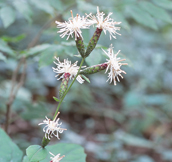
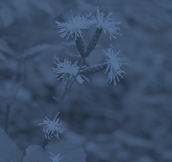 Pertya robusta Compositae
Pertya robusta Compositae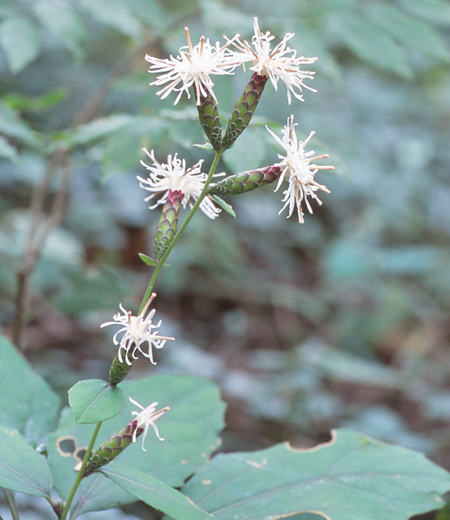 They are a perennial plant that grows at the arid places such as in the pool of the forests and in the forests at the mountain area (Perennial plant takes several years to grow). The rhizome (Konkei) creeps sideways and the stalks are not split but expand straight. The flower consists of apitulum (Touka: a flower consisting of small dense tubular flowers) of 10 small flowers in cluster, and 5 to 6 of them are on the upper part of the stalk. The flower is tinged with white with the tips split into 5 and curled back. A circular cylindrical shape involucre (Soho: a portion like a bud to cover) lie below the flower, about 1.7 to 2.7 cm long. The leaf is elliptically-shaped like the one of Quercus dentate, about 10 to 20 cm long, with coarse sawtooth at the edge (Kyoshi: tooth-like rough part like a saw at the root of a leaf). They have a long stalk and the leaves grow alternative in cluster in the middle of the stalk. When the flowers wither, they bear the seeds about 1.4 cm long and with floss. In the winter, the liquid inside the withered stems get frozen to be swollen to be ‘Shimobashira’ (Ice Flower).
They are a perennial plant that grows at the arid places such as in the pool of the forests and in the forests at the mountain area (Perennial plant takes several years to grow). The rhizome (Konkei) creeps sideways and the stalks are not split but expand straight. The flower consists of apitulum (Touka: a flower consisting of small dense tubular flowers) of 10 small flowers in cluster, and 5 to 6 of them are on the upper part of the stalk. The flower is tinged with white with the tips split into 5 and curled back. A circular cylindrical shape involucre (Soho: a portion like a bud to cover) lie below the flower, about 1.7 to 2.7 cm long. The leaf is elliptically-shaped like the one of Quercus dentate, about 10 to 20 cm long, with coarse sawtooth at the edge (Kyoshi: tooth-like rough part like a saw at the root of a leaf). They have a long stalk and the leaves grow alternative in cluster in the middle of the stalk. When the flowers wither, they bear the seeds about 1.4 cm long and with floss. In the winter, the liquid inside the withered stems get frozen to be swollen to be ‘Shimobashira’ (Ice Flower).
●Season Mid September to about Mid October
●Height about 30 to 70 cm
●Place Trail 1 to 6, Mt.Inari, Jyataki, Ura-Takao, Oku-Takao -
Rhynchospermum verticillatum Compositae
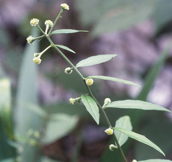
 Rhynchospermum verticillatum Compositae
Rhynchospermum verticillatum Compositae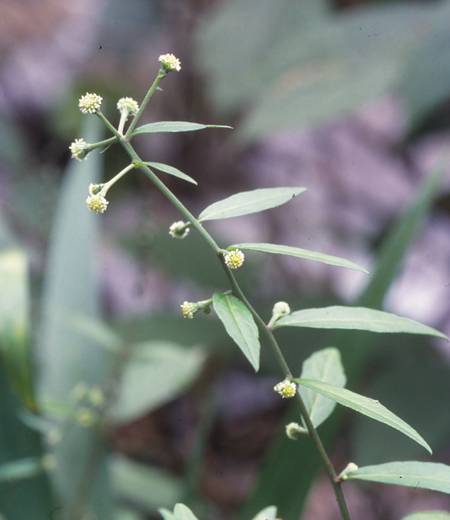 They are a perennial plant that grows in the pool of the forests and at the roadsides along the mountain streams at the mountain area (Perennial plant takes several years to grow). Their flowers come into high season around the time when the autumn is come. This is the reason for the name. When the stalk grows to be about 1 m high, it shoots 2 to 4 of offshoots and bears a small flower at the top of the short stem growing from the side of the leaf. The flower consists of apitulum (Touka: a flower consisting of small dense tubular flowers, to be like one flower), about 5 mm, tinged with pale yellow-green. In its center, gathers a tubular flower (Toujoka: tubular corolla that gathers dense in the center, also a flower with no flower petals) with the tip split into 5, while small white flower petals like protuberance around it queue up in 2 lines to surround. The leaf is thin and long elliptically-shaped, about 7 to 15 cm long, about 2 to 3 cm wide with the sharp top, and has hard and short trichome on (Shiga: a gyrose jagged part) both surfaces, rough feeling to touch with a gyrose tooth(at the edge of the upper portion. When he flowers wither, they bear the elliptically-shaped, seeds about 2.5 mm long.
They are a perennial plant that grows in the pool of the forests and at the roadsides along the mountain streams at the mountain area (Perennial plant takes several years to grow). Their flowers come into high season around the time when the autumn is come. This is the reason for the name. When the stalk grows to be about 1 m high, it shoots 2 to 4 of offshoots and bears a small flower at the top of the short stem growing from the side of the leaf. The flower consists of apitulum (Touka: a flower consisting of small dense tubular flowers, to be like one flower), about 5 mm, tinged with pale yellow-green. In its center, gathers a tubular flower (Toujoka: tubular corolla that gathers dense in the center, also a flower with no flower petals) with the tip split into 5, while small white flower petals like protuberance around it queue up in 2 lines to surround. The leaf is thin and long elliptically-shaped, about 7 to 15 cm long, about 2 to 3 cm wide with the sharp top, and has hard and short trichome on (Shiga: a gyrose jagged part) both surfaces, rough feeling to touch with a gyrose tooth(at the edge of the upper portion. When he flowers wither, they bear the elliptically-shaped, seeds about 2.5 mm long.
●Season Mid September to about Mid October
●Height about 50 to 90 cm
●Place Trail 1 to 6, Mt. Inari, Jyataki, Ura-Takao -
Aster scaber Compositae
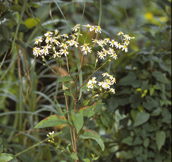
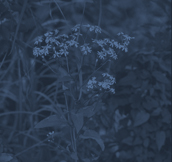 Aster scaber Compositae
Aster scaber Compositae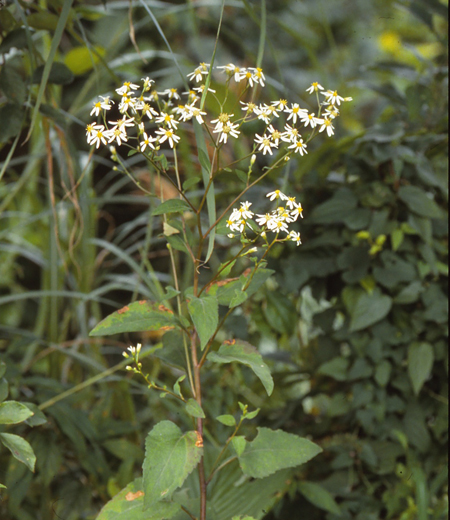 They are common perennial plant that grows at sunny arid places (perennial plant takes several years to grow). The stalk and the leaf have short paraphyllium and rough to touch. Long and thin stalk is often divided at the top into lots of capitulum (Touka: a flower consisting of small dense tubular flowers) bloom. The flower is about 2 cm in diameter. In its center gathers a yellow tubular flower (Toujoka: tubular corolla that gathers dense in the center, also a flower with no flower petals) gather and white ligulate flower (Zetsujoka: porions around a tubular flower, ordinarily named a flower peal) grow sparsely around it. Leaves at lower part are about 9 to 24 cm long, about 6 to 18 cm wide, thin heat-shaped, long-shanked with narrow fins, and have coarse sawtooth at the edge (Kyoshi: tooth-like rough part like a saw at the root of a leaf). The upper the leaf grows, the shorter the stalk becomes. Occasionally, gall (gall growth formed by insects’ parasite) is developed on the leaf like a small sprout. While Kalimeris pseudoyomena in the same group is ‘Yomena’, they are called ‘Mukona’ and their green shoot are good for edible wild plants in spring.
They are common perennial plant that grows at sunny arid places (perennial plant takes several years to grow). The stalk and the leaf have short paraphyllium and rough to touch. Long and thin stalk is often divided at the top into lots of capitulum (Touka: a flower consisting of small dense tubular flowers) bloom. The flower is about 2 cm in diameter. In its center gathers a yellow tubular flower (Toujoka: tubular corolla that gathers dense in the center, also a flower with no flower petals) gather and white ligulate flower (Zetsujoka: porions around a tubular flower, ordinarily named a flower peal) grow sparsely around it. Leaves at lower part are about 9 to 24 cm long, about 6 to 18 cm wide, thin heat-shaped, long-shanked with narrow fins, and have coarse sawtooth at the edge (Kyoshi: tooth-like rough part like a saw at the root of a leaf). The upper the leaf grows, the shorter the stalk becomes. Occasionally, gall (gall growth formed by insects’ parasite) is developed on the leaf like a small sprout. While Kalimeris pseudoyomena in the same group is ‘Yomena’, they are called ‘Mukona’ and their green shoot are good for edible wild plants in spring.
●Season August to about October
●Height about 1 to 1.5 m
●Place Trail 1 , Trail 5, Mt.Inari , Ura-Takao, Oku-Takao -
Aster ageratoides ssp. leiophyllus Compositae
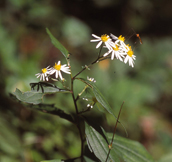
 Aster ageratoides ssp. leiophyllus Compositae
Aster ageratoides ssp. leiophyllus Compositae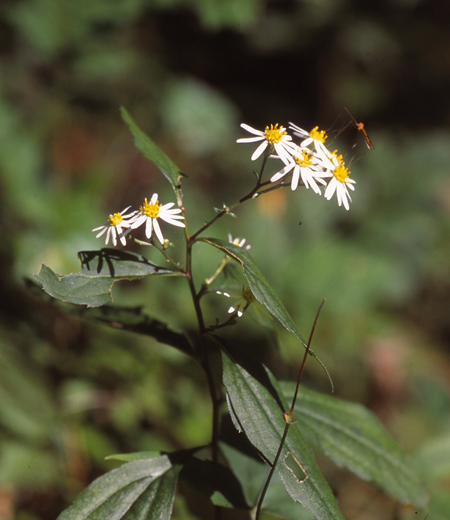 They are common perennial plant that grows at roadsides under the trees in mountain areas. (Perennial plant takes several years to grow). The stalk has white paraphyllium here and there. The tip of the stalk is divided at the top into lots of capitulum (Touka: a flower consisting of small dense tubular flowers) bloom 1.5 to 2 cm in diameter and with top branches short stalk where several flowers bloom in group. Around a yellow tubular flower (Toujoka: tubular corolla that gathers dense in the center, also a flower with no flower petals), 8 to 13 of white ligulate flowers (Zetsujoka: porions around a tubular flower, ordinarily named a flower peal) grow. At the root of the flowers lies about 4 mm long involucre (Soho: transformed leaves to wrap the flower base). They bear white blossoms like Kalimeris pseudoyomena in the same group. That’s the reason they are named. The leaf is elliptically-shaped about 10 to 15 cm wide and has a stalk, where leaves grow alternate on the stalk. The surface is rough, the tip is sharp, and it has a large sawtooth at the edge (Kyoshi: tooth-like rough part like a saw at the root of a leaf). When flowers wither, they bear the seed about 3 to 5 mm long with paraphyllium. In winter moisture in the withered stalks freeze to be ice-flower like ‘Shimobashira’.
They are common perennial plant that grows at roadsides under the trees in mountain areas. (Perennial plant takes several years to grow). The stalk has white paraphyllium here and there. The tip of the stalk is divided at the top into lots of capitulum (Touka: a flower consisting of small dense tubular flowers) bloom 1.5 to 2 cm in diameter and with top branches short stalk where several flowers bloom in group. Around a yellow tubular flower (Toujoka: tubular corolla that gathers dense in the center, also a flower with no flower petals), 8 to 13 of white ligulate flowers (Zetsujoka: porions around a tubular flower, ordinarily named a flower peal) grow. At the root of the flowers lies about 4 mm long involucre (Soho: transformed leaves to wrap the flower base). They bear white blossoms like Kalimeris pseudoyomena in the same group. That’s the reason they are named. The leaf is elliptically-shaped about 10 to 15 cm wide and has a stalk, where leaves grow alternate on the stalk. The surface is rough, the tip is sharp, and it has a large sawtooth at the edge (Kyoshi: tooth-like rough part like a saw at the root of a leaf). When flowers wither, they bear the seed about 3 to 5 mm long with paraphyllium. In winter moisture in the withered stalks freeze to be ice-flower like ‘Shimobashira’.
●Season August to about November
●Height about 30cm to 1m
●Place Trail 1,Trail 3 to 6, Mt.Inari , Ura-Takao, Oku-Takao -
Saussurea sinuatoides Compositae
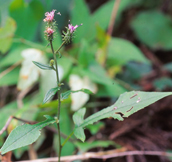
 Saussurea sinuatoides Compositae
Saussurea sinuatoides Compositae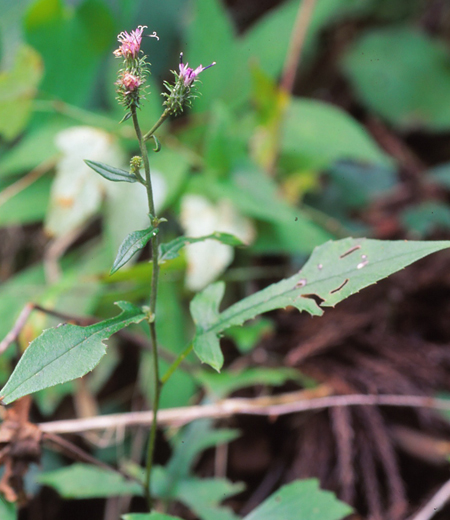 They are perennial plant that grows at the pool of mountain district and forests. (Perennial plant takes several years to grow). They were first discovered at Mt. Takao and named in 1909, the group of Saussurea. The flower is capitulum (Touka: a flower consisting of small dense tubular flowers) about 2 cm in diameter with some purplish red color flowers in the upper part of stalk. The involucre (Soho: transformed leaves to wrap the flower base) at the root of flowers is bell contour shape about 1.8 cm long, and the tip of involucral bract is sharp. The leaves growing under radical leaf (Konseiyou: leaves growing near the root of stalk) and under the stalk are wide-egg shaped about 7 to 11 cm long with long stalk and sawtooth at the edge (Kyoshi: tooth-like rough part like a saw at the root of a leaf). The leaves are gouged deep halfway and the characteristic is the shape looks like a violin. At Mt Jinbayama we see rarely Saussurea x satowi which is crossbreed between Saussurea sinuatoides and Saussurea tanakae, and also the leaves are a violin shaped. Radical leaf withers at the season when the flowers bloom. When flowers bloom, radical leaf withers. They bear seeds with white trichome. Using the trichome, the seeds are carried by wind.
They are perennial plant that grows at the pool of mountain district and forests. (Perennial plant takes several years to grow). They were first discovered at Mt. Takao and named in 1909, the group of Saussurea. The flower is capitulum (Touka: a flower consisting of small dense tubular flowers) about 2 cm in diameter with some purplish red color flowers in the upper part of stalk. The involucre (Soho: transformed leaves to wrap the flower base) at the root of flowers is bell contour shape about 1.8 cm long, and the tip of involucral bract is sharp. The leaves growing under radical leaf (Konseiyou: leaves growing near the root of stalk) and under the stalk are wide-egg shaped about 7 to 11 cm long with long stalk and sawtooth at the edge (Kyoshi: tooth-like rough part like a saw at the root of a leaf). The leaves are gouged deep halfway and the characteristic is the shape looks like a violin. At Mt Jinbayama we see rarely Saussurea x satowi which is crossbreed between Saussurea sinuatoides and Saussurea tanakae, and also the leaves are a violin shaped. Radical leaf withers at the season when the flowers bloom. When flowers bloom, radical leaf withers. They bear seeds with white trichome. Using the trichome, the seeds are carried by wind.
●Season Late September to about Late October
●Height about 40 to 80 cm
●Place Trail 4 ,Oku-Takao -
Cirsium nipponicum var. incomptum Compositae
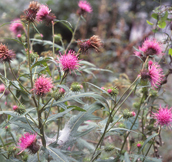
 Cirsium nipponicum var. incomptum Compositae
Cirsium nipponicum var. incomptum Compositae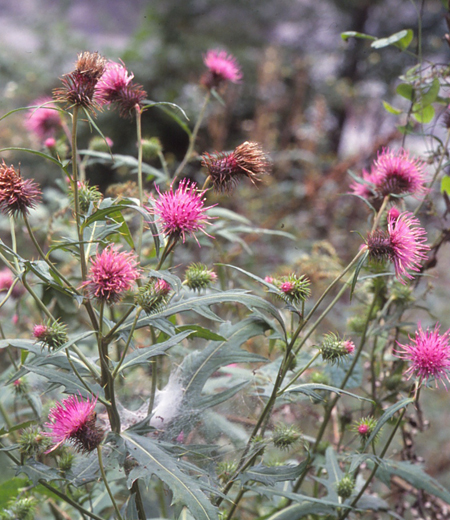 They are perennial plant that grows at the pool in the forests of mountain district and glassfields. (Perennial plant takes several years to grow). They are varietas of Cirsium nipponicum (inhabiting in central Japan of main land Honsyu) and as seen in Kanto region they have alias name ‘Cirsium nipponicum var. incomptum’. Another name is known by Cirsium nipponicum var. incomptum which means large thistle. The flower is purplish red color capitulum (Touka: a flower consisting of small dense tubular flowers) about 2.5 to 3 cm in diameter, and bloom sideways or slightly to a downward direction on the stalk a lot. The involucre (Soho: transformed leaves to wrap the flower base) at the root of flowers is bell contour shape, and the needle-pointed involucral bract is rolling back. The leaf is thin and long about 20 to 30 cm with the tip pointed and branch-shaped portion projecting. It has thick and long aculeus, and painful to touch. When the flowers wither, they bear the seeds 2 mm long. The seeds have pale brownish paraphyllium so that they will be carried by wind.
They are perennial plant that grows at the pool in the forests of mountain district and glassfields. (Perennial plant takes several years to grow). They are varietas of Cirsium nipponicum (inhabiting in central Japan of main land Honsyu) and as seen in Kanto region they have alias name ‘Cirsium nipponicum var. incomptum’. Another name is known by Cirsium nipponicum var. incomptum which means large thistle. The flower is purplish red color capitulum (Touka: a flower consisting of small dense tubular flowers) about 2.5 to 3 cm in diameter, and bloom sideways or slightly to a downward direction on the stalk a lot. The involucre (Soho: transformed leaves to wrap the flower base) at the root of flowers is bell contour shape, and the needle-pointed involucral bract is rolling back. The leaf is thin and long about 20 to 30 cm with the tip pointed and branch-shaped portion projecting. It has thick and long aculeus, and painful to touch. When the flowers wither, they bear the seeds 2 mm long. The seeds have pale brownish paraphyllium so that they will be carried by wind.
●Season Mid September to about Late October
●Height about 60cm to 1.5m
●Place Trail 1,Trail 2,Ura-Takao,Oku-Takao -
Carpesium rosulatum Compositae
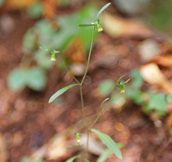
 Carpesium rosulatum Compositae
Carpesium rosulatum Compositae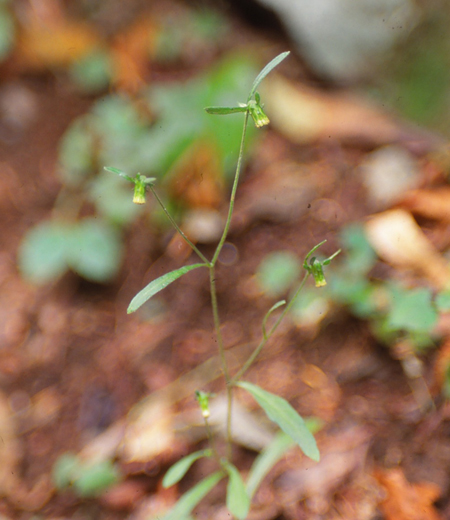 They are perennial plant that grows in the somewhat arid forests of mountain district and in the pool of forests. (Perennial plant takes several years to grow). Radical leaf (Konseiyou: leaves growing near the root of stalk) spreads on the ground radially. From its center does grow a thin stalk with soft, dense paraphyllium and they bear 1 flower downward at the top, which looks like a bowl of tobbaco pipe on the top of a pipe. The flower is a yellow capitulum (Touka: a flower consisting of small dense tubular flowers) about 5 mm in diameter and the smallest among Japanese Carpesium divaricatum group. The involucre (Soho: transformed leaves to wrap the flower base) at the root of flowers is bell contour shape about 6.5 mm long. A radical leaf is paddle shaped about 6 to 15 cm long with spiny sawtooth at the edge (Kyoshi: tooth-like rough part like a saw at the root of a leaf). The leaves grow effuse and alternate on the stalk. A radical leaf remains, even when the time of bloom is come. When flowers wither, they bear the seed about 3.5 mm long. The seed produces mucilage from the top so that the seed will be attached and carried.
They are perennial plant that grows in the somewhat arid forests of mountain district and in the pool of forests. (Perennial plant takes several years to grow). Radical leaf (Konseiyou: leaves growing near the root of stalk) spreads on the ground radially. From its center does grow a thin stalk with soft, dense paraphyllium and they bear 1 flower downward at the top, which looks like a bowl of tobbaco pipe on the top of a pipe. The flower is a yellow capitulum (Touka: a flower consisting of small dense tubular flowers) about 5 mm in diameter and the smallest among Japanese Carpesium divaricatum group. The involucre (Soho: transformed leaves to wrap the flower base) at the root of flowers is bell contour shape about 6.5 mm long. A radical leaf is paddle shaped about 6 to 15 cm long with spiny sawtooth at the edge (Kyoshi: tooth-like rough part like a saw at the root of a leaf). The leaves grow effuse and alternate on the stalk. A radical leaf remains, even when the time of bloom is come. When flowers wither, they bear the seed about 3.5 mm long. The seed produces mucilage from the top so that the seed will be attached and carried.
●Season Late August to about Early October
●Height about 15 to 45 cm
●Place Trail 1 to 6, Mt.Inari, Jyataki, Iroha, Ura-Takao, Oku-Takao,Minami- Takao,Kita-Takao -
Eupatorium chinense Compositae
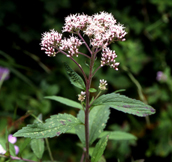
 Eupatorium chinense Compositae
Eupatorium chinense Compositae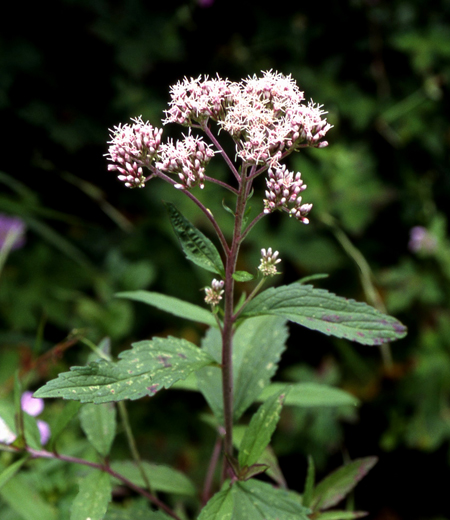 They are perennial plant that grows at such sunny places as in the forests of mountain district and in the pool of forests. (Perennial plant takes several years to grow). The stalk has scrupulous paraphyllium and rough to touch. The name come from that they blossom about the time when brown-eared bulbul (Hypsipetes amaurotis) comes down and often sings. The flower is capitulum (Touka: a flower consisting of small dense tubular flowers) that consists of 5 tubular flowers (Toujoka: tubular corolla that gathers dense in the center, also a flower with no flower petals), about 5 mm in diameter, and many grow on the upper part of the branch. The color is white or pale red. Butterflies like Parantica sita gather together much. Though each flower is very small, the top of the flower petal is divided into 5 and 2 separate pistils sprout long from the inside. The leaf is long and thin elliptically-shaped about 10 to 18 cm long and has short stem attaching toward the stalk. Both of the surfaces have short sparse paraphyllium and sawtooth at the edge (sawtooth: Kyoshi, serrated edges like a saw- serrated edges at the tip of a leaf), and also have Glandular point at the back.
They are perennial plant that grows at such sunny places as in the forests of mountain district and in the pool of forests. (Perennial plant takes several years to grow). The stalk has scrupulous paraphyllium and rough to touch. The name come from that they blossom about the time when brown-eared bulbul (Hypsipetes amaurotis) comes down and often sings. The flower is capitulum (Touka: a flower consisting of small dense tubular flowers) that consists of 5 tubular flowers (Toujoka: tubular corolla that gathers dense in the center, also a flower with no flower petals), about 5 mm in diameter, and many grow on the upper part of the branch. The color is white or pale red. Butterflies like Parantica sita gather together much. Though each flower is very small, the top of the flower petal is divided into 5 and 2 separate pistils sprout long from the inside. The leaf is long and thin elliptically-shaped about 10 to 18 cm long and has short stem attaching toward the stalk. Both of the surfaces have short sparse paraphyllium and sawtooth at the edge (sawtooth: Kyoshi, serrated edges like a saw- serrated edges at the tip of a leaf), and also have Glandular point at the back.
●Season Mid August to about Mid October
●Height about 1 to 2 m
●Place Ura-Takao -
Carpesium abrotanoides Compositae
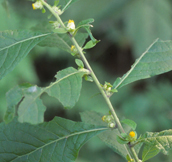
 Carpesium abrotanoides Compositae
Carpesium abrotanoides Compositae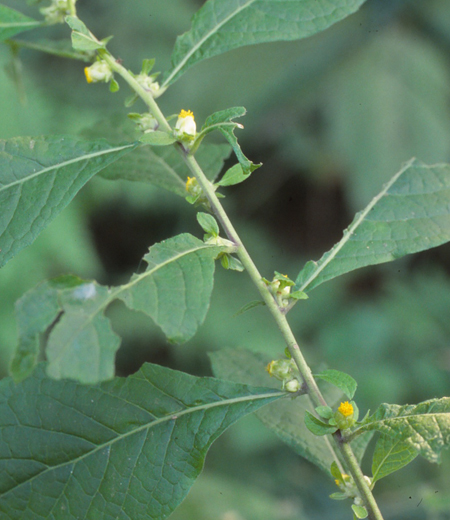 Biennial herbs (sprout in autumn and bloom on the following year) found at forest edges near streams and roadside in mountains. Grow normally in shrubs and have large wrinkly leaves resembling leaves of tabacco, hence the Japanese name Yabu-tabako literally meaning shrubs tabacco. Stems are thick and once they grow up to 1m, radiate some branches. Radical leaves (leaves grow from roots) and leaves on lower parts of stems are about 25 to 30 cm long, 10 to 15 cm width and elongated oval-shape. Texture is thin and has short hair on both sides. Leaves become smaller as it goes up and radical leaves wither during blooming season. Flowers are 1 cm in diameters flower head (small tubular shaped flowers densely placed creating one flower) and bloom in a line facing downward. The color is yellow and has disk floret (tubular shaped flowers without petals densely placed in the center) in the center surrounded by female flowers. After flowering, bears about 3.5 mm long seeds and exudes sticky juice and carried with animals or clothes.
Biennial herbs (sprout in autumn and bloom on the following year) found at forest edges near streams and roadside in mountains. Grow normally in shrubs and have large wrinkly leaves resembling leaves of tabacco, hence the Japanese name Yabu-tabako literally meaning shrubs tabacco. Stems are thick and once they grow up to 1m, radiate some branches. Radical leaves (leaves grow from roots) and leaves on lower parts of stems are about 25 to 30 cm long, 10 to 15 cm width and elongated oval-shape. Texture is thin and has short hair on both sides. Leaves become smaller as it goes up and radical leaves wither during blooming season. Flowers are 1 cm in diameters flower head (small tubular shaped flowers densely placed creating one flower) and bloom in a line facing downward. The color is yellow and has disk floret (tubular shaped flowers without petals densely placed in the center) in the center surrounded by female flowers. After flowering, bears about 3.5 mm long seeds and exudes sticky juice and carried with animals or clothes.
●Season Early September to about Mid October
●Height 50 cm to 1 m
●Place Trail 3, Trail 6, Oku-Takao -
Chrysanthemum makinoi Compositae
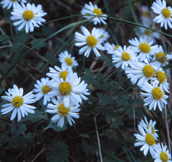
 Chrysanthemum makinoi Compositae
Chrysanthemum makinoi Compositae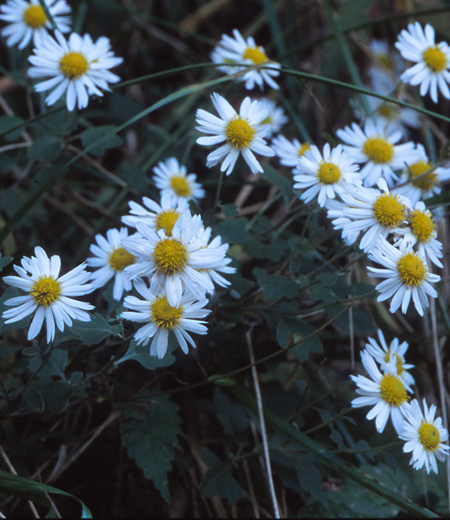 They are perennial plant that grows at the sunny places along ridges and hills (Perennial plant takes several years to grow). The stalk is thin with dense paraphyllium, and sparsely-branched at the top of the stalk. Oil smelling incense-like flavor named Borneol Oil belongs to the stalk and the leaf. This is why they are named ‘santhemum makinoi’. The flower consists of tubular flowers (Toujoka: tubular corolla that gathers dense in the center, also a flower with no flower petals), about 2.5 mm in diameter, around a yellow tubular flower (Toujoka: tubular corolla that gathers dense in the center, also a flower with no flower petals) sprout white or pale red ligulate flower (Zetsujoka: porions around a tubular flower, ordinarily named a flower peal) grow around it. At the root of the flowers lies about 7 mm long hemispherically-shaped involucre (Soho: transformed leaves to wrap the flower base) with narrow involucral bract in three series. The leaf is about 4 to 8 cm long, is usually divided into three, has short footstalk, and grows alternative. The back of the leaf has scrupulous dense trichome like grayish white with large sawtooth (Kyoshi, serrated edges like a saw- serrated edges at the tip of a leaf) at the edge.
They are perennial plant that grows at the sunny places along ridges and hills (Perennial plant takes several years to grow). The stalk is thin with dense paraphyllium, and sparsely-branched at the top of the stalk. Oil smelling incense-like flavor named Borneol Oil belongs to the stalk and the leaf. This is why they are named ‘santhemum makinoi’. The flower consists of tubular flowers (Toujoka: tubular corolla that gathers dense in the center, also a flower with no flower petals), about 2.5 mm in diameter, around a yellow tubular flower (Toujoka: tubular corolla that gathers dense in the center, also a flower with no flower petals) sprout white or pale red ligulate flower (Zetsujoka: porions around a tubular flower, ordinarily named a flower peal) grow around it. At the root of the flowers lies about 7 mm long hemispherically-shaped involucre (Soho: transformed leaves to wrap the flower base) with narrow involucral bract in three series. The leaf is about 4 to 8 cm long, is usually divided into three, has short footstalk, and grows alternative. The back of the leaf has scrupulous dense trichome like grayish white with large sawtooth (Kyoshi, serrated edges like a saw- serrated edges at the tip of a leaf) at the edge.
●Season Mid October to about Mid November
●Height about 40 to 80 cm
●Place Trail 1, Mt.Inari, Jyataki, Iroha, Ura-Takao,Oku-Takao -
Codonopsis lanceolata Campanulaceae
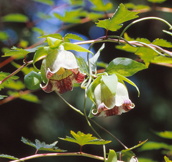
 Codonopsis lanceolata Campanulaceae
Codonopsis lanceolata Campanulaceae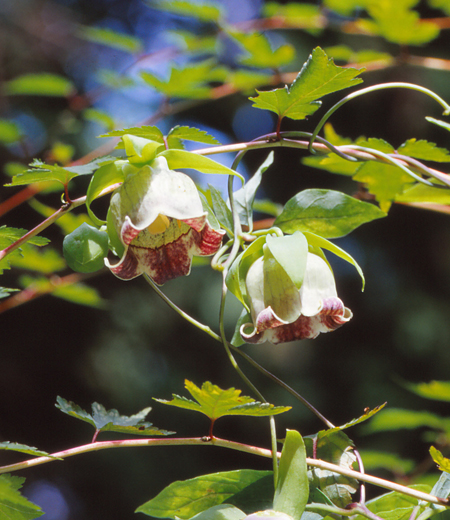 They are a perennial climbing plant that ordinarily grows in the pool of the forests and in the forests at the mountain area (Perennial plant takes several years to grow). As a big rootstalk resembles Panax ginseng, they are named. The dots inside of the flower petals are likened as granddad’s skin spots, and consequently they have another name ‘Codonopsis lanceolata Trautv.’ (Jii-sobu: Sobu means dialect name for skin spots in Kiso region). The flower is bell contour shape about 2.5 to 3 cm long, and the flowers bloom downward at the top of a lateral branch. The flowers are tinged with green white with the inside tinged with purple patterns and the tip of the flower petal is split into 5 and rolled back. The leaf is long egged-shaped about 3 to 10 cm with the sharp tip, and soft feeling to touch with the back in powdery white. When damaged, the stem and the leaves produce the white fluid that smells so horrible When the flowers wither, they bear the star-shaped seeds about 2 cm in diameter. Matured seeds are split out to let the brown seedlings with wing-like.
They are a perennial climbing plant that ordinarily grows in the pool of the forests and in the forests at the mountain area (Perennial plant takes several years to grow). As a big rootstalk resembles Panax ginseng, they are named. The dots inside of the flower petals are likened as granddad’s skin spots, and consequently they have another name ‘Codonopsis lanceolata Trautv.’ (Jii-sobu: Sobu means dialect name for skin spots in Kiso region). The flower is bell contour shape about 2.5 to 3 cm long, and the flowers bloom downward at the top of a lateral branch. The flowers are tinged with green white with the inside tinged with purple patterns and the tip of the flower petal is split into 5 and rolled back. The leaf is long egged-shaped about 3 to 10 cm with the sharp tip, and soft feeling to touch with the back in powdery white. When damaged, the stem and the leaves produce the white fluid that smells so horrible When the flowers wither, they bear the star-shaped seeds about 2 cm in diameter. Matured seeds are split out to let the brown seedlings with wing-like.
●Season Early September to about Mid October
●Height Vines
●Place Ura-Takao,Oku-Takao -
Phtheirospermum japonicum Scrophulariaceae
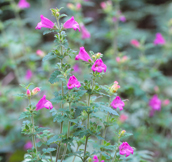
 Phtheirospermum japonicum Scrophulariaceae
Phtheirospermum japonicum Scrophulariaceae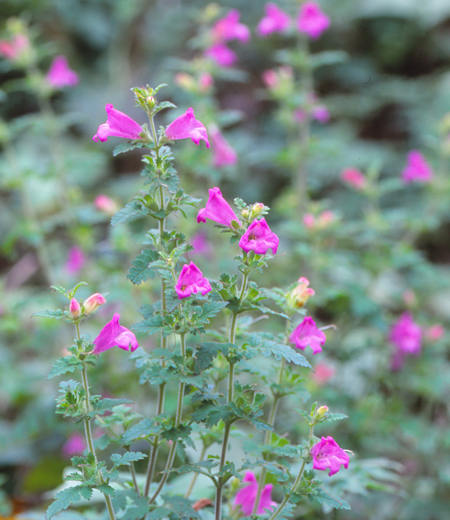 They are perennial plant that grows at the sunny roadsides and grasslands in the mountain district. (Hemiparasite perennial plant takes several years to grow). They themselves produce nourishment by photosynthesis as well as expand the roots to the ones of the other plants to take nourishment at the same time. They have soft thick glandular trichome entirely. This glandular trichome produces mucilage that is sticky to touch. The flower is pale red-purple about 1.5 to 2 cm long, like the shape of one's lip, with one flower at the side of the leaf of upper part of the branch. The petal at the upper part has the tip split up a bit as well as rolling back. The petal at the bottom part spreads widely dividing into 3. The leaf is a triangle shape, about 3 to 5 cm long an 2 to 3.5 cm wide, pinnately-branched, and have a sharp sawtooth at the edge (Kyoshi: tooth-like rough part like a saw at the root of a leaf). After flowers wither, they bear about 1 cm long egg-shaped seeds with the sharp tip. 3 to 5 seeds.
They are perennial plant that grows at the sunny roadsides and grasslands in the mountain district. (Hemiparasite perennial plant takes several years to grow). They themselves produce nourishment by photosynthesis as well as expand the roots to the ones of the other plants to take nourishment at the same time. They have soft thick glandular trichome entirely. This glandular trichome produces mucilage that is sticky to touch. The flower is pale red-purple about 1.5 to 2 cm long, like the shape of one's lip, with one flower at the side of the leaf of upper part of the branch. The petal at the upper part has the tip split up a bit as well as rolling back. The petal at the bottom part spreads widely dividing into 3. The leaf is a triangle shape, about 3 to 5 cm long an 2 to 3.5 cm wide, pinnately-branched, and have a sharp sawtooth at the edge (Kyoshi: tooth-like rough part like a saw at the root of a leaf). After flowers wither, they bear about 1 cm long egg-shaped seeds with the sharp tip. 3 to 5 seeds.
●Season September to about October
●Height about 30 to 60 cm
●Place Ura-Takao -
Salvia japonica Thunb Labiatae
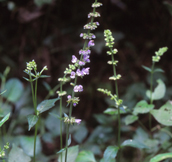
 Salvia japonica Thunb Labiatae
Salvia japonica Thunb Labiatae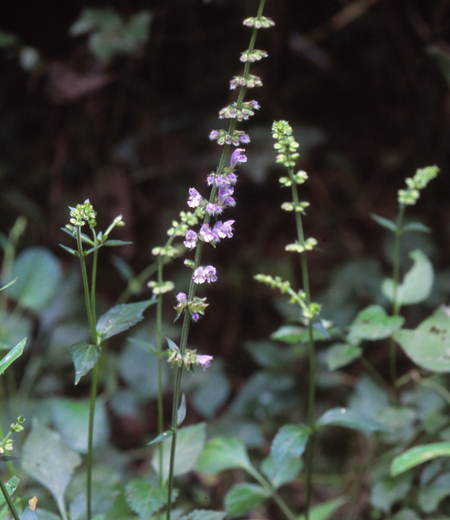 They are common perennial plant that grows at the roadsides in the mountain districts. (Perennial plant takes several years to grow). The stalk is circular in cross-section the same as the others in Labiatae group. On spikes (Kasui: small flowers gathering to be like head of plant) about 10 to 20 cm long grown-high upward on stalk, pale purple-tinged flowers whorled (Rinsei: leaves growing as if they are wrapping the stalk) like terraces. The flowers are 1 to 1.3 cm long with the upper flower petals upright and the bottom one split into 3. Outside the flower petals, white paraphyllium grows thickly, and calyxes bear much glandular trichome. The leaves consist of 3 to 7 as one to be like wings opening, which is imparipinnate compound leaf (Ujohukuyou: the shape of the leaves that numerous small leaves grow at leafstalk). The leaves grow opposite each other on the stalk and the ones at the bottom have a long footstalk. Lobules (Shoyo: each one that is leaf-shaped and leaf like one consisting of more than a few leaves) is egged-shape, 2 to 5 cm long, and has rounded sawtooth (Kyoshi: tooth-like rough part like a saw at the root of a leaf) at the edge. After flowers wither, many calyxes on spikes (Kasui: small flowers gathering to be like head of plant) like gathering in a ring around still remain. Some leaves turn red in autumn, some are ‘Kusamomiji’.
They are common perennial plant that grows at the roadsides in the mountain districts. (Perennial plant takes several years to grow). The stalk is circular in cross-section the same as the others in Labiatae group. On spikes (Kasui: small flowers gathering to be like head of plant) about 10 to 20 cm long grown-high upward on stalk, pale purple-tinged flowers whorled (Rinsei: leaves growing as if they are wrapping the stalk) like terraces. The flowers are 1 to 1.3 cm long with the upper flower petals upright and the bottom one split into 3. Outside the flower petals, white paraphyllium grows thickly, and calyxes bear much glandular trichome. The leaves consist of 3 to 7 as one to be like wings opening, which is imparipinnate compound leaf (Ujohukuyou: the shape of the leaves that numerous small leaves grow at leafstalk). The leaves grow opposite each other on the stalk and the ones at the bottom have a long footstalk. Lobules (Shoyo: each one that is leaf-shaped and leaf like one consisting of more than a few leaves) is egged-shape, 2 to 5 cm long, and has rounded sawtooth (Kyoshi: tooth-like rough part like a saw at the root of a leaf) at the edge. After flowers wither, many calyxes on spikes (Kasui: small flowers gathering to be like head of plant) like gathering in a ring around still remain. Some leaves turn red in autumn, some are ‘Kusamomiji’.
●Season Mid August to about Late October
●Height about 20 to 50 cm
●Place Trail 1 to 6, Mt.Inari, Jyataki, Ura-Takao, Oku-Takao -
Keiskea japonica Labiatae
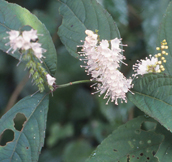
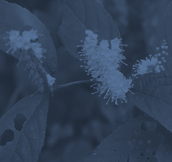 Keiskea japonica Labiatae
Keiskea japonica Labiatae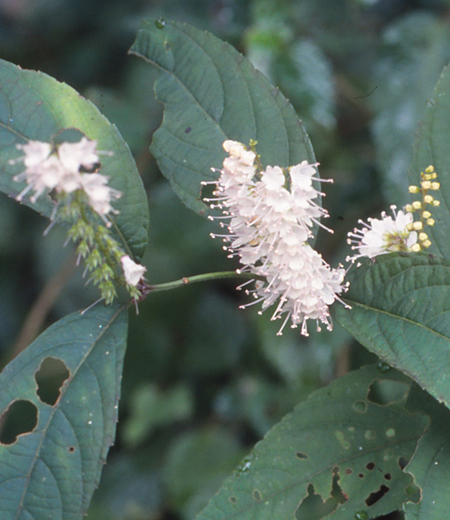 They are perennial plant that grows at the shade of trees in the mountain districts. (Perennial plant takes several years to grow). In winter, moisture in the withered stalks freeze swollen and breaking out to be bloom ice-flower. This is why they are named ‘Shimobashira’. Spikes (Kasui: small flowers gathering to be like head of plant) about 10 to 20 cm long grow upper side of stalk and bear numerous flowers only on one side. The flower is about 7 to 8 mm long with the upper flower petals split shallow into 2 and the bottom ones into 3. From the inside, a male stamen and a female one sprout out and their pink color pollen are beautiful. The flower petals are rustle and the feeling is a Japanese paper to touch. The leaf is elliptically-shaped about 8 to 20 cm long 3 to 5.5 cm wide with short stalk, and grows opposite each other on the stalk. Their characteristic of a leaf is thin and soft, the surface of the leaf and has small paraphyllium along the veins and sawtooth (Kyoshi: tooth-like rough part like a saw at the root of a leaf) at the edge.
They are perennial plant that grows at the shade of trees in the mountain districts. (Perennial plant takes several years to grow). In winter, moisture in the withered stalks freeze swollen and breaking out to be bloom ice-flower. This is why they are named ‘Shimobashira’. Spikes (Kasui: small flowers gathering to be like head of plant) about 10 to 20 cm long grow upper side of stalk and bear numerous flowers only on one side. The flower is about 7 to 8 mm long with the upper flower petals split shallow into 2 and the bottom ones into 3. From the inside, a male stamen and a female one sprout out and their pink color pollen are beautiful. The flower petals are rustle and the feeling is a Japanese paper to touch. The leaf is elliptically-shaped about 8 to 20 cm long 3 to 5.5 cm wide with short stalk, and grows opposite each other on the stalk. Their characteristic of a leaf is thin and soft, the surface of the leaf and has small paraphyllium along the veins and sawtooth (Kyoshi: tooth-like rough part like a saw at the root of a leaf) at the edge.
●Season Early September to about Mid October
●Height about 50 to 70 cm
●Place Trail 1, Trail 5, Mt.Inari, Ura-Takao, Oku-Takao, Minami-Takao -
Elsholtzia ciliata Labiatae
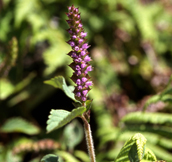
 Elsholtzia ciliata Labiatae
Elsholtzia ciliata Labiatae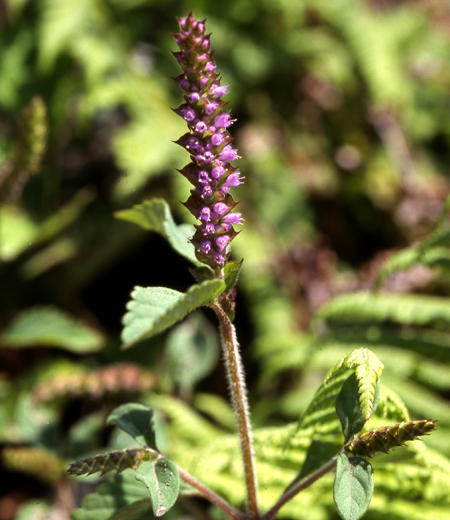 They are an annual plant that grow at the pool of forests in the mountain areas, grasslands at the roadsides, and at sunny places, and that has strong incense. The stalk is circular in cross-section and white soft glandular trichome grows in clusters with the top split in many cases. On spikes (Kasui: small flowers gathering to be like head of plant) about 10 to 15 cm long, pale purple-tinged flowers whorled. The appearance of spikes (Kasui) rolling back is compared as Naginata, a partisana pole sword, and this plant is named ‘Elsholtzia ciliata’ (Naginata Kouzyu). ‘Kouzyu’ ia a Chinese name. The flower is about 5 mm long. As the edge is split off minutely, it looks like growing glandular trichome, and roundish bract leaf spread (Houyou: a modified leaf or leaflike part just below flower stalk) at the back of the leaf get into line. The leaf is egged-shaped about 3 to 9 cm long, about 1 to 4 cm wide with the sharp tip, grows opposite each other on the stalk. Lot of subspecies sprout at the back of the leaves, and sawtooth (Kyoshi: tooth-like rough part like a saw at the root of a leaf) at the edge.
They are an annual plant that grow at the pool of forests in the mountain areas, grasslands at the roadsides, and at sunny places, and that has strong incense. The stalk is circular in cross-section and white soft glandular trichome grows in clusters with the top split in many cases. On spikes (Kasui: small flowers gathering to be like head of plant) about 10 to 15 cm long, pale purple-tinged flowers whorled. The appearance of spikes (Kasui) rolling back is compared as Naginata, a partisana pole sword, and this plant is named ‘Elsholtzia ciliata’ (Naginata Kouzyu). ‘Kouzyu’ ia a Chinese name. The flower is about 5 mm long. As the edge is split off minutely, it looks like growing glandular trichome, and roundish bract leaf spread (Houyou: a modified leaf or leaflike part just below flower stalk) at the back of the leaf get into line. The leaf is egged-shaped about 3 to 9 cm long, about 1 to 4 cm wide with the sharp tip, grows opposite each other on the stalk. Lot of subspecies sprout at the back of the leaves, and sawtooth (Kyoshi: tooth-like rough part like a saw at the root of a leaf) at the edge.
●Season Late September to about Late October
●Height about 30 to 60 cm
●Place Trail 1 to 6, Mt.Inari, Jyataki, Ura-Takao -
Rabdosia japonica Labiatae
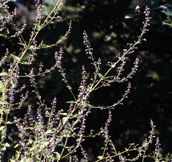
 Rabdosia japonica Labiatae
Rabdosia japonica Labiatae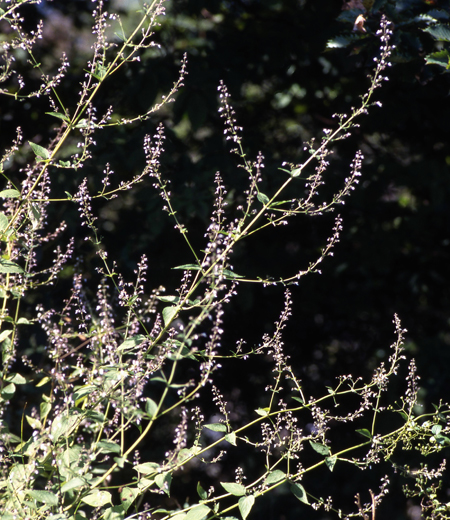 They are perennial plant that grows at the grasslands and in the forests in the hilly areas. (Perennial plant takes several years to grow). The stalk is circular in cross-section and dense glandular trichome grows downward in clusters. According the legend, the bitter flavor of the leaf is so strong that it makes even fallen sick man lifted up. And that the name is also related to KOUBOU-DAISHI. He gave the squeeze of this leaf to the fallen holy man, the holy man gets well. Furthermore, it is said that the longer the one lives, the better the medicinal benefits gets, and thus they are also named ‘Plectranthus japonicus’. It is also said that entire grounded grass powder works for stomachache and stomach upset. The flower is about 5 to 7 mm long, almost whitish pale purple, and grows on the side of the top of the branch and the leaf. The upper flower petal is just upright with the shallow tip, split into 4, and patterns of dark purple color. The bottom petals thrust their heads forward to cover a long male stamen and a long female stamen. The leaf is wide egged-shaped about 6 to 15 cm long, and grows opposite each other on the stalk with the same long sawtooth (Kyoshi: tooth-like rough part like a saw at the root of a leaf) at the edge.
They are perennial plant that grows at the grasslands and in the forests in the hilly areas. (Perennial plant takes several years to grow). The stalk is circular in cross-section and dense glandular trichome grows downward in clusters. According the legend, the bitter flavor of the leaf is so strong that it makes even fallen sick man lifted up. And that the name is also related to KOUBOU-DAISHI. He gave the squeeze of this leaf to the fallen holy man, the holy man gets well. Furthermore, it is said that the longer the one lives, the better the medicinal benefits gets, and thus they are also named ‘Plectranthus japonicus’. It is also said that entire grounded grass powder works for stomachache and stomach upset. The flower is about 5 to 7 mm long, almost whitish pale purple, and grows on the side of the top of the branch and the leaf. The upper flower petal is just upright with the shallow tip, split into 4, and patterns of dark purple color. The bottom petals thrust their heads forward to cover a long male stamen and a long female stamen. The leaf is wide egged-shaped about 6 to 15 cm long, and grows opposite each other on the stalk with the same long sawtooth (Kyoshi: tooth-like rough part like a saw at the root of a leaf) at the edge.
●Season Early September to about Mid of October
●Height about 50 cm to 1 m
●Place Oku-Takao -
Plectranthus inflexus Labiatae
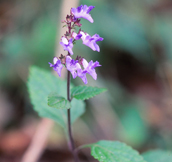
 Plectranthus inflexus Labiatae
Plectranthus inflexus Labiatae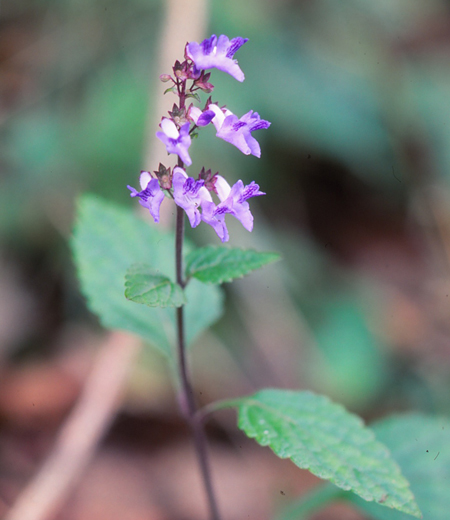 They are perennial plant that grows at such sunny places as at the pool of forests in the mountain area. (Perennial plant takes several years to grow). From the underground stem which becomes composition, does stand erect the stem with trichome downward. They are named after that they grow in the mountain area the same with Mentha arvensis var.piperascens (Labiatae), but they don’t smell Mentha arvensis var.piperascens. The flower is pale bluish-purple about 1 cm long. Out on a limb, thin spikes (Kasui: small flowers gathering to be like head of plant) sprout and some of them each are like terraces. The upper flower petal is split into 4 to grow upstraight with patterns of dark purple color. The bottom petal is split into 2 and thrusts its head forward with the edge face inward. According to this structure, when an insect stops to sit there, consequently a male stamen and a female stamen do peep out, so that the insects surely carry stamen. The leaf is wide egged-shaped about 3 to 6 cm long, 2 to 4 cm wide, with leafstalk bearing fins, and the rough sawtooth (Kyoshi: tooth-like rough part like a saw at the root of a leaf) at the edge.
They are perennial plant that grows at such sunny places as at the pool of forests in the mountain area. (Perennial plant takes several years to grow). From the underground stem which becomes composition, does stand erect the stem with trichome downward. They are named after that they grow in the mountain area the same with Mentha arvensis var.piperascens (Labiatae), but they don’t smell Mentha arvensis var.piperascens. The flower is pale bluish-purple about 1 cm long. Out on a limb, thin spikes (Kasui: small flowers gathering to be like head of plant) sprout and some of them each are like terraces. The upper flower petal is split into 4 to grow upstraight with patterns of dark purple color. The bottom petal is split into 2 and thrusts its head forward with the edge face inward. According to this structure, when an insect stops to sit there, consequently a male stamen and a female stamen do peep out, so that the insects surely carry stamen. The leaf is wide egged-shaped about 3 to 6 cm long, 2 to 4 cm wide, with leafstalk bearing fins, and the rough sawtooth (Kyoshi: tooth-like rough part like a saw at the root of a leaf) at the edge.
●Season Mid September to about Late October
●Height about 40 to 80 cm
●Place Trail 1, Trail 3 to 6, Ura-Takao, Oku-Takao -
Perilla frutescens var. citriodora Labiatae
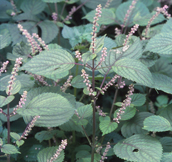
 Perilla frutescens var. citriodora Labiatae
Perilla frutescens var. citriodora Labiatae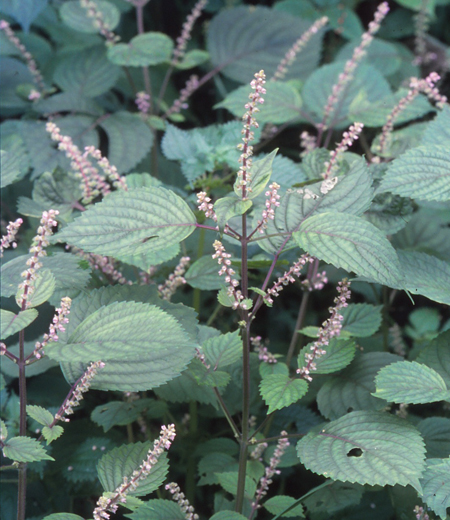 They are an annual plant that grows in the pool and along the forest road in a submontane district and forests on a hillside. The stalk is circular in cross-section and short soft glandular trichome grows in clusters and many are tinged with red-purple. The stalk is circular in cross-section and white soft glandular trichome grows in clusters with the top split in many cases. On spikes (Kasui: small flowers gathering to be like head of plant) about 10 to 15 cm long, pale purple-tinged flowers whorled. When you knead the leaves, they smell like lemons, and also the appearance resembles the one of Perilla frutescens (L.) Bitt.var.frutescens. This is why they are named. This is the plant that was first discovered in Mt. Takao in 1913. The flower is pale showy pink about 5 millimeters long, and blossoms on inflorescence (Kajo: stalk blooming flowers) grown from the top branch, about 10 to 18 cm long. The leaf is wide egged-shaped about 7 to 12 cm long, 5 to 8 cm wide, grows alternative on the stalk. The veins have soft paraphyllium, the Glandular point stands out at the back, and the same shaped sawtooth (Kyoshi: tooth-like rough part like a saw at the root of a leaf) along the edge. Calyxes growing white long trichome bear the seeds, which grow to be about 6 to 7 mm large in diameter and hold the seeds.
They are an annual plant that grows in the pool and along the forest road in a submontane district and forests on a hillside. The stalk is circular in cross-section and short soft glandular trichome grows in clusters and many are tinged with red-purple. The stalk is circular in cross-section and white soft glandular trichome grows in clusters with the top split in many cases. On spikes (Kasui: small flowers gathering to be like head of plant) about 10 to 15 cm long, pale purple-tinged flowers whorled. When you knead the leaves, they smell like lemons, and also the appearance resembles the one of Perilla frutescens (L.) Bitt.var.frutescens. This is why they are named. This is the plant that was first discovered in Mt. Takao in 1913. The flower is pale showy pink about 5 millimeters long, and blossoms on inflorescence (Kajo: stalk blooming flowers) grown from the top branch, about 10 to 18 cm long. The leaf is wide egged-shaped about 7 to 12 cm long, 5 to 8 cm wide, grows alternative on the stalk. The veins have soft paraphyllium, the Glandular point stands out at the back, and the same shaped sawtooth (Kyoshi: tooth-like rough part like a saw at the root of a leaf) along the edge. Calyxes growing white long trichome bear the seeds, which grow to be about 6 to 7 mm large in diameter and hold the seeds.
●Season Mid September to about Early October
●Height about 20 to 70 cm
●Place Ura-Takao -
Cuscuta japonica Convolvulaceae
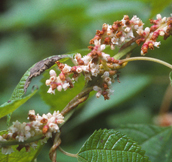
 Cuscuta japonica Convolvulaceae
Cuscuta japonica Convolvulaceae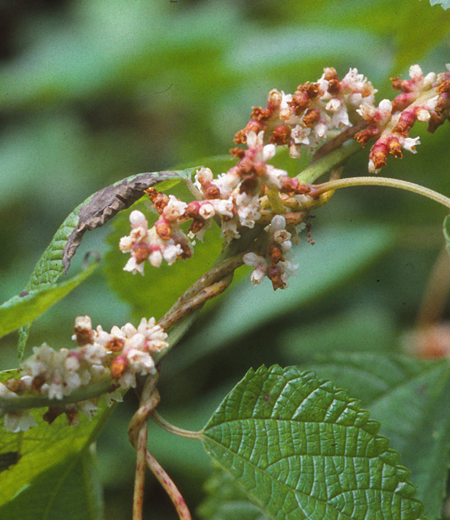 They are a climbing, parasitic annual plant that grows by expanding a climbing vein to the grasslands in sunny mountain district and bushy trees to tangle with them so that they absorb nourishment by inserting parasitic root into them. At first they have underground roots, but once they begin to parasite other plants, their underground roots wither. This is why they are named ‘Cuscuta japonica’. They have no chlorophyll and their leaves are only scale-like leaf about 2 mm long. The stalk is about 1.5 mm thick, tinged with yellowish, and has brown patterns.Short spikes (Kasui: small flowers gathering to be like head of plant) sprout from the halfway stalk with many small white flowers bloom upward. The flower is bell contour shape about 4 mm long, the tip of the flower petal split into 5. When the flowers wither, they bear the egged-shaped seeds about 4 mm long. When matured, the seeds are slit laterally and the upper cover is taken off to spread out the black seedling about 3 mm long.
They are a climbing, parasitic annual plant that grows by expanding a climbing vein to the grasslands in sunny mountain district and bushy trees to tangle with them so that they absorb nourishment by inserting parasitic root into them. At first they have underground roots, but once they begin to parasite other plants, their underground roots wither. This is why they are named ‘Cuscuta japonica’. They have no chlorophyll and their leaves are only scale-like leaf about 2 mm long. The stalk is about 1.5 mm thick, tinged with yellowish, and has brown patterns.Short spikes (Kasui: small flowers gathering to be like head of plant) sprout from the halfway stalk with many small white flowers bloom upward. The flower is bell contour shape about 4 mm long, the tip of the flower petal split into 5. When the flowers wither, they bear the egged-shaped seeds about 4 mm long. When matured, the seeds are slit laterally and the upper cover is taken off to spread out the black seedling about 3 mm long.
●Season about September
●Height Vines
●Place Ura-Takao -
Swertia japonica Gentianaceae
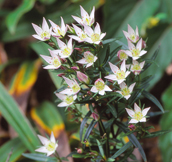
 Swertia japonica Gentianaceae
Swertia japonica Gentianaceae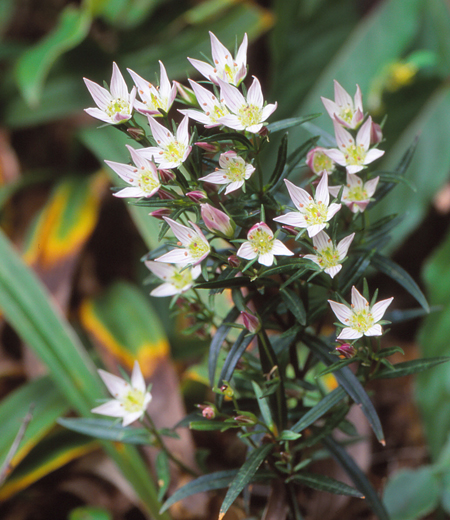 They are a biennial grass that grows at arid grasslands along the ridge (biennial grass: he plant which sprouts in autumn, passes the winter, and then blossoms in the next spring). The stalk is circular in cross-section and mostly tinged with purple color with the root split into several stalks. As an old-established method, they are utilized as gastrointestinal agent. Entire plant is dried and grounded to be brewed to produce the agent, but it is said that even if this gastrointestinal agent brewed 1,000 times, they taste bitterest. This is how they are named ‘Swertia japonica’ (Senburi). (Furidasu means the agents in the bag is soaked into boiling water and is brewed.) They bear some white flowers which have pale purple-tinged stripes at the side of a limb and leaf. The flower is about 1.5 cm in diameter, and the flower petal is deep split into 5 to be star-shaped. At the knuckle inside of it, there are elliptical-shaped floral nectaries for each, where they grow long trichome. The leaves are thin and long about 2 to 4 cm long and grow alternative. On occasion, they are tinged with purple with the edge a bit rolling outward.
They are a biennial grass that grows at arid grasslands along the ridge (biennial grass: he plant which sprouts in autumn, passes the winter, and then blossoms in the next spring). The stalk is circular in cross-section and mostly tinged with purple color with the root split into several stalks. As an old-established method, they are utilized as gastrointestinal agent. Entire plant is dried and grounded to be brewed to produce the agent, but it is said that even if this gastrointestinal agent brewed 1,000 times, they taste bitterest. This is how they are named ‘Swertia japonica’ (Senburi). (Furidasu means the agents in the bag is soaked into boiling water and is brewed.) They bear some white flowers which have pale purple-tinged stripes at the side of a limb and leaf. The flower is about 1.5 cm in diameter, and the flower petal is deep split into 5 to be star-shaped. At the knuckle inside of it, there are elliptical-shaped floral nectaries for each, where they grow long trichome. The leaves are thin and long about 2 to 4 cm long and grow alternative. On occasion, they are tinged with purple with the edge a bit rolling outward.
●Season Mid October to about Mid November
●Height about 10 to 20 cm
●Place Trail 5, Oku-Takao -
Gentiana scabra var. buergeri(Gentian) Gentianaceae
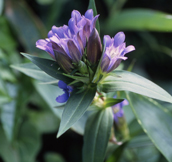
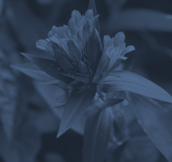 Gentiana scabra var. buergeri(Gentian) Gentianaceae
Gentiana scabra var. buergeri(Gentian) Gentianaceae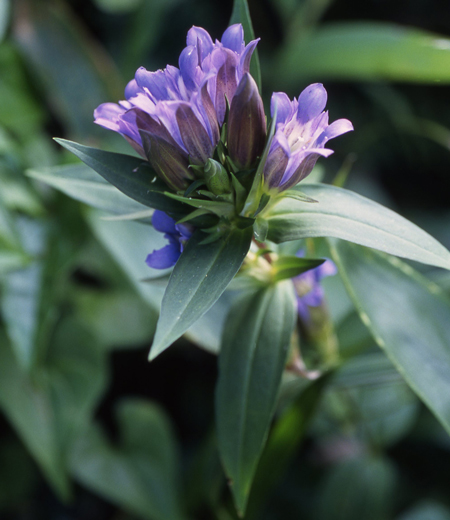 They are perennial plant that grows at such sunny places as in the grasslands in the forests in the mountain area. (Perennial plant takes several years to grow). The stalk rises to its full height and the leaf is not split. In Kanji (Chinese characters), ‘Gentianae Scabrae Radix’ (Ryutan) derives its name from the sound. They bear flowers in bell contour shape about 4 to 5 cm long, and the tip is split into 5 with trigonous accessory flocculuses between each of 5. The inside of the flower has dark brown patterns. The leaf is thin egged-shaped about 3 to 8 cm long and grows alternative like holding the stalk. 3 leaf veins show up so well and the edge of the leaf has thin tip, which results in rough feeling to touch. They bear the seeds surrounded with the withered flowers, and then when the seeds get matured, they split off to let the small seedlings with wings out. Dried rhizome are utilized as stomachic.
They are perennial plant that grows at such sunny places as in the grasslands in the forests in the mountain area. (Perennial plant takes several years to grow). The stalk rises to its full height and the leaf is not split. In Kanji (Chinese characters), ‘Gentianae Scabrae Radix’ (Ryutan) derives its name from the sound. They bear flowers in bell contour shape about 4 to 5 cm long, and the tip is split into 5 with trigonous accessory flocculuses between each of 5. The inside of the flower has dark brown patterns. The leaf is thin egged-shaped about 3 to 8 cm long and grows alternative like holding the stalk. 3 leaf veins show up so well and the edge of the leaf has thin tip, which results in rough feeling to touch. They bear the seeds surrounded with the withered flowers, and then when the seeds get matured, they split off to let the small seedlings with wings out. Dried rhizome are utilized as stomachic.
●Season Mid October to about Mid November
●Height about 20 to 80 cm
●Place Oku-Takao -
Angelica polymorpha Umbelliferae
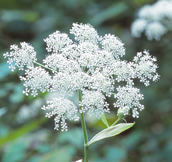
 Angelica polymorpha Umbelliferae
Angelica polymorpha Umbelliferae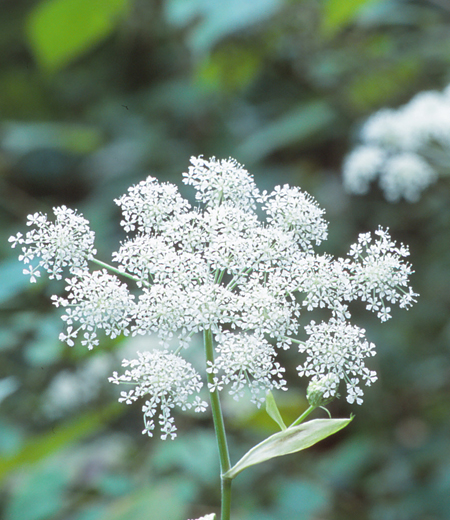 They are perennial plant that grows at such humid places as at the shade of the trees in the mountain districts. (Perennial plant takes several years to grow). The stalk is straight-grown and hollow with the upper part sparsely branched. They are discovered for the first time at Mt. Nikko-Shirane and their appearance looks like the one of Cnidium officinale Makino (Umbelliferae) which is medical plants native to China. This is why they are named. On inflorescence (Kajo: stalk blooming flowers) grown from the top branch, sprout lots of small white flowers to be a cluster about 5 to 9 cm in diameter. The flower is about 5 mm in diameter with 5 curved flower petals inside of it as well as long male stamen growing in a radial fashion. The leaves triply or quadruply consist of pinnately compound leaf (Ujohukuyou: the leaf growing shape and style that bear some smaller leaves at the leafstalk), and are split into lots of lobules (Shoyo: each one that is leaf-shaped and leaf like one consisting of more than a few leaves) to blossom widely. Lobules are elliptically-shaped about 3 to 6 cm long, have a sharp tip and have sawtooth at the edge (sawtooth: Kyoshi, serrated edges like a saw- serrated edges at the tip of a leaf). Their characteristic of a leaf is thin and not shiny with the back in white like being flour-coated.
They are perennial plant that grows at such humid places as at the shade of the trees in the mountain districts. (Perennial plant takes several years to grow). The stalk is straight-grown and hollow with the upper part sparsely branched. They are discovered for the first time at Mt. Nikko-Shirane and their appearance looks like the one of Cnidium officinale Makino (Umbelliferae) which is medical plants native to China. This is why they are named. On inflorescence (Kajo: stalk blooming flowers) grown from the top branch, sprout lots of small white flowers to be a cluster about 5 to 9 cm in diameter. The flower is about 5 mm in diameter with 5 curved flower petals inside of it as well as long male stamen growing in a radial fashion. The leaves triply or quadruply consist of pinnately compound leaf (Ujohukuyou: the leaf growing shape and style that bear some smaller leaves at the leafstalk), and are split into lots of lobules (Shoyo: each one that is leaf-shaped and leaf like one consisting of more than a few leaves) to blossom widely. Lobules are elliptically-shaped about 3 to 6 cm long, have a sharp tip and have sawtooth at the edge (sawtooth: Kyoshi, serrated edges like a saw- serrated edges at the tip of a leaf). Their characteristic of a leaf is thin and not shiny with the back in white like being flour-coated.
●Season Late September to about Late October
●Height about 80 cm to 1.5 m
●Place Trail 1, Trail 4, Trail 6, Ura-Takao, Oku-Takao -
Angelica decursiva Umbelliferae
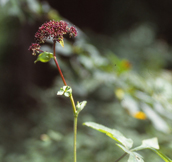
 Angelica decursiva Umbelliferae
Angelica decursiva Umbelliferae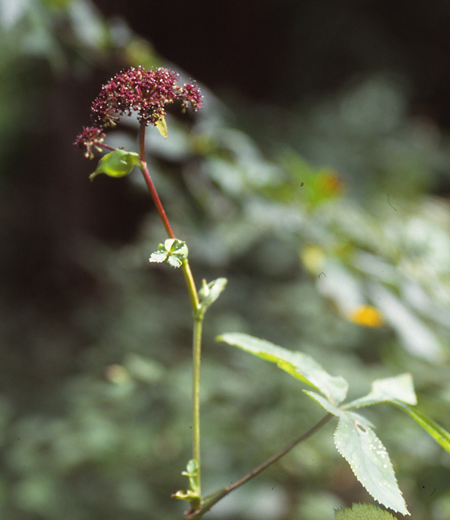 They are perennial plant that grows in the pool of forests, in the forests, and at grasslands in the mountain districts. (Perennial plant takes several years to grow). The upright-growing stalk is divided at the upper part into a few portions and is tinged with dark purplish. Though there are many white plants in the group of Umbelliferae, this plant is rarely tinged with dark purplish. More rarely, there are green ones or white ones. The flower is about 2 mm in diameter, on inflorescence (Kajo: stalk blooming flowers) grown from the top branch, sprout lots of flowers to be a cluster. As 5 flower petals face inward, they are seen as a flower bud even when they are blooming, and a male stamen projects outward from the inside. The leaf is compound leaf consisting of 3 leaves as one. Lobules are elliptically-shaped about 3 to 6 cm long (Shoyo: each one that is leaf-shaped and leaf like one consisting of more than a few leaves) is split deeply and has a rough sawtooth at the edge (sawtooth: Kyoshi, serrated edges like a saw-serrated edges at the tip of a leaf) with the back in whitish color. The characteristic is the portion at the leafstalk gets swollen to be saclike as a hull that holds the stalk. The seed is a cracked elliptically-shaped about 6 cm long and smells like curry.
They are perennial plant that grows in the pool of forests, in the forests, and at grasslands in the mountain districts. (Perennial plant takes several years to grow). The upright-growing stalk is divided at the upper part into a few portions and is tinged with dark purplish. Though there are many white plants in the group of Umbelliferae, this plant is rarely tinged with dark purplish. More rarely, there are green ones or white ones. The flower is about 2 mm in diameter, on inflorescence (Kajo: stalk blooming flowers) grown from the top branch, sprout lots of flowers to be a cluster. As 5 flower petals face inward, they are seen as a flower bud even when they are blooming, and a male stamen projects outward from the inside. The leaf is compound leaf consisting of 3 leaves as one. Lobules are elliptically-shaped about 3 to 6 cm long (Shoyo: each one that is leaf-shaped and leaf like one consisting of more than a few leaves) is split deeply and has a rough sawtooth at the edge (sawtooth: Kyoshi, serrated edges like a saw-serrated edges at the tip of a leaf) with the back in whitish color. The characteristic is the portion at the leafstalk gets swollen to be saclike as a hull that holds the stalk. The seed is a cracked elliptically-shaped about 6 cm long and smells like curry.
●Season Late August to about Early October
●Height about 80 cm to 1.5 m
●Place Trail 1, Trail 5, Ura-Takao, Oku-Takao -
Spuriopimpinella nikoensis Umbelliferae
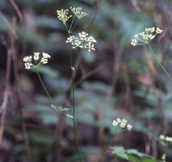
 Spuriopimpinella nikoensis Umbelliferae
Spuriopimpinella nikoensis Umbelliferae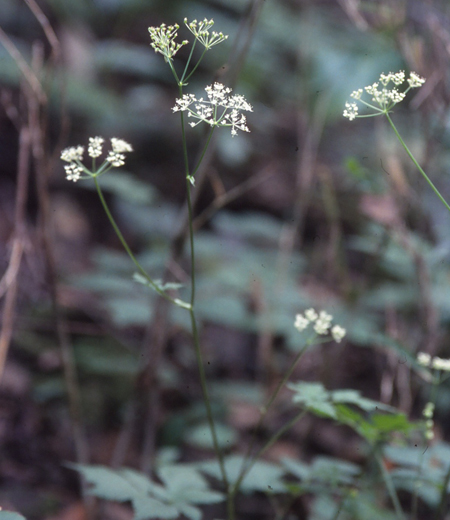 They are perennial plant that grows at such gloomy and humid places as in the pool of forests, in the forests in the mountain districts. (Perennial plant takes several years to grow). We seldom see them at Mt. Takao. The stalk is pillar-shaped and upright, and is divided at the upper part into. They grow in the shade and the shape of the leaf looks like the one of Cryptotaenia japonica, which is why they are named. The flower is white about 2 mm in diameter, on inflorescence (Kajo: stalk blooming flowers) grown from the top branch, sprout about 10 flowers to be a cluster. There are some such clusters. 5 flower petals face inward, and a male stamen projects long outward from the inside while a female stamen is split into 2 at the top. The leaf is twice ternate compound leaf consisting of 3 leaves as one on the 3-split branched top. The leaf has a long stalk and the leaves grow alternative on the stalk. Lobules are elliptically-shaped about 2 to 10 cm long (Shoyo: each one that is leaf-shaped and leaf like one consisting of more than a few leaves) and has a rough sawtooth at the edge (sawtooth: Kyoshi, serrated edges like a saw-serrated edges at the tip of a leaf). The characteristic of the leaf is thin and soft to touch.
They are perennial plant that grows at such gloomy and humid places as in the pool of forests, in the forests in the mountain districts. (Perennial plant takes several years to grow). We seldom see them at Mt. Takao. The stalk is pillar-shaped and upright, and is divided at the upper part into. They grow in the shade and the shape of the leaf looks like the one of Cryptotaenia japonica, which is why they are named. The flower is white about 2 mm in diameter, on inflorescence (Kajo: stalk blooming flowers) grown from the top branch, sprout about 10 flowers to be a cluster. There are some such clusters. 5 flower petals face inward, and a male stamen projects long outward from the inside while a female stamen is split into 2 at the top. The leaf is twice ternate compound leaf consisting of 3 leaves as one on the 3-split branched top. The leaf has a long stalk and the leaves grow alternative on the stalk. Lobules are elliptically-shaped about 2 to 10 cm long (Shoyo: each one that is leaf-shaped and leaf like one consisting of more than a few leaves) and has a rough sawtooth at the edge (sawtooth: Kyoshi, serrated edges like a saw-serrated edges at the tip of a leaf). The characteristic of the leaf is thin and soft to touch.
●Season Early September to about Early October
●Height about 30 to 80 cm
●Place Oku-Takao
